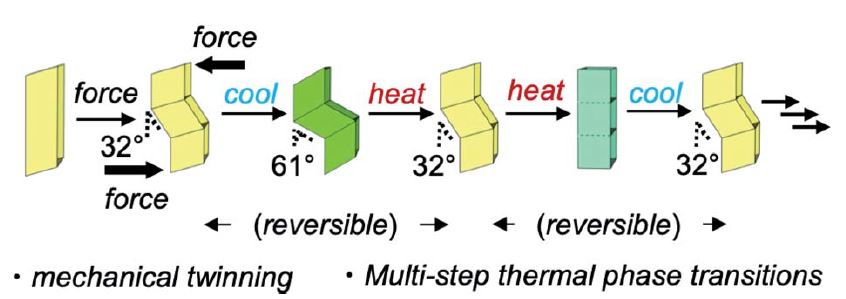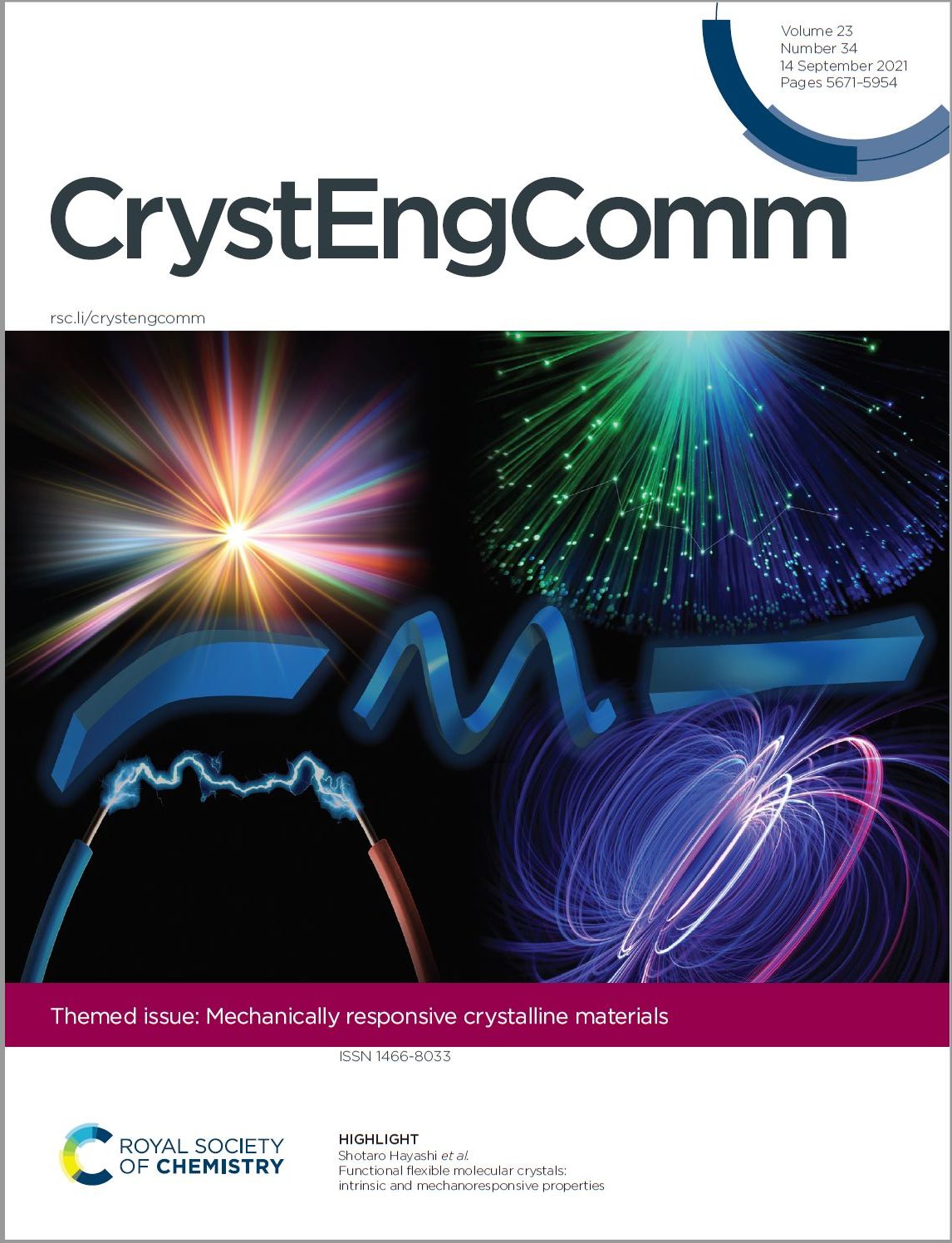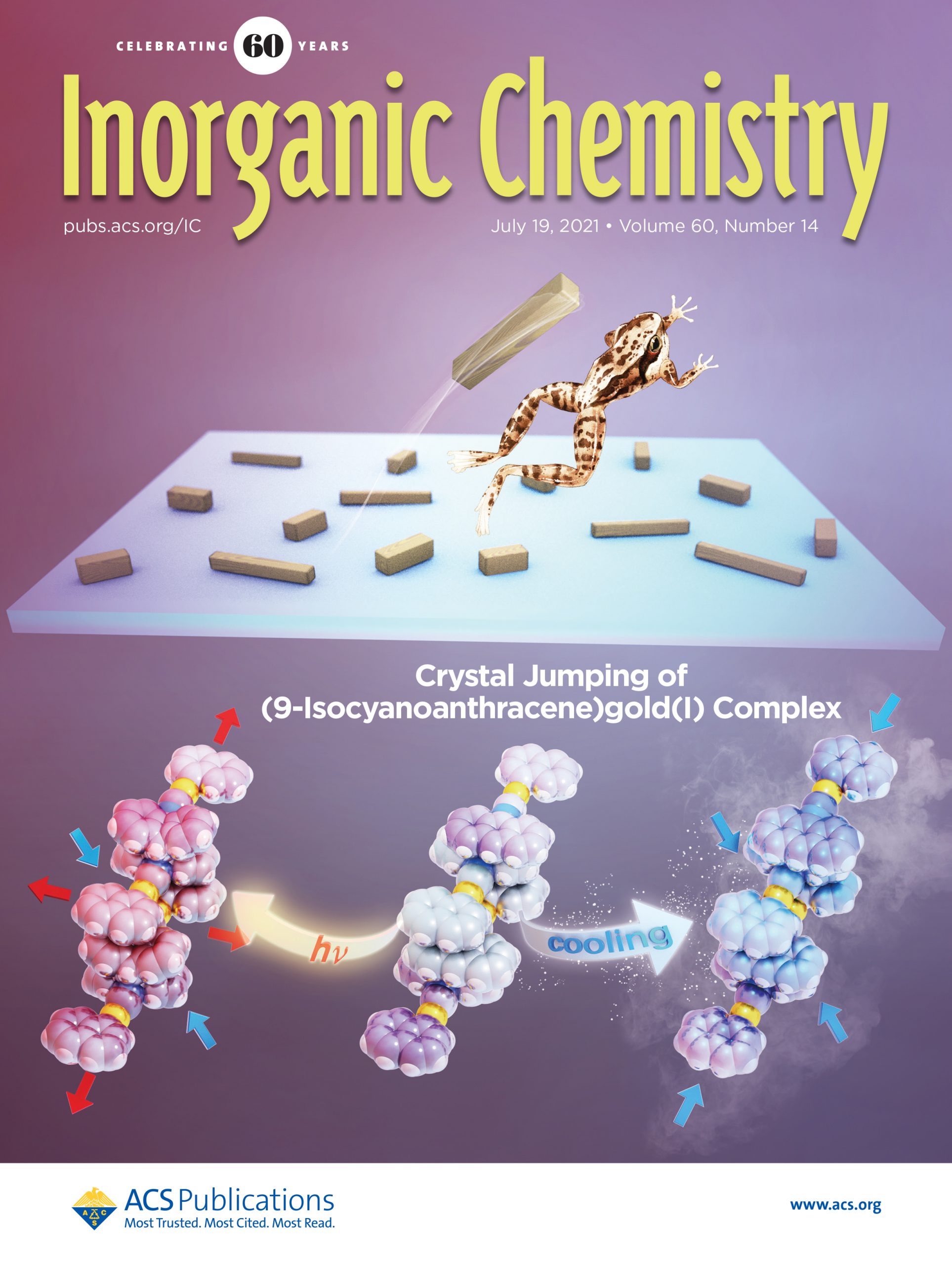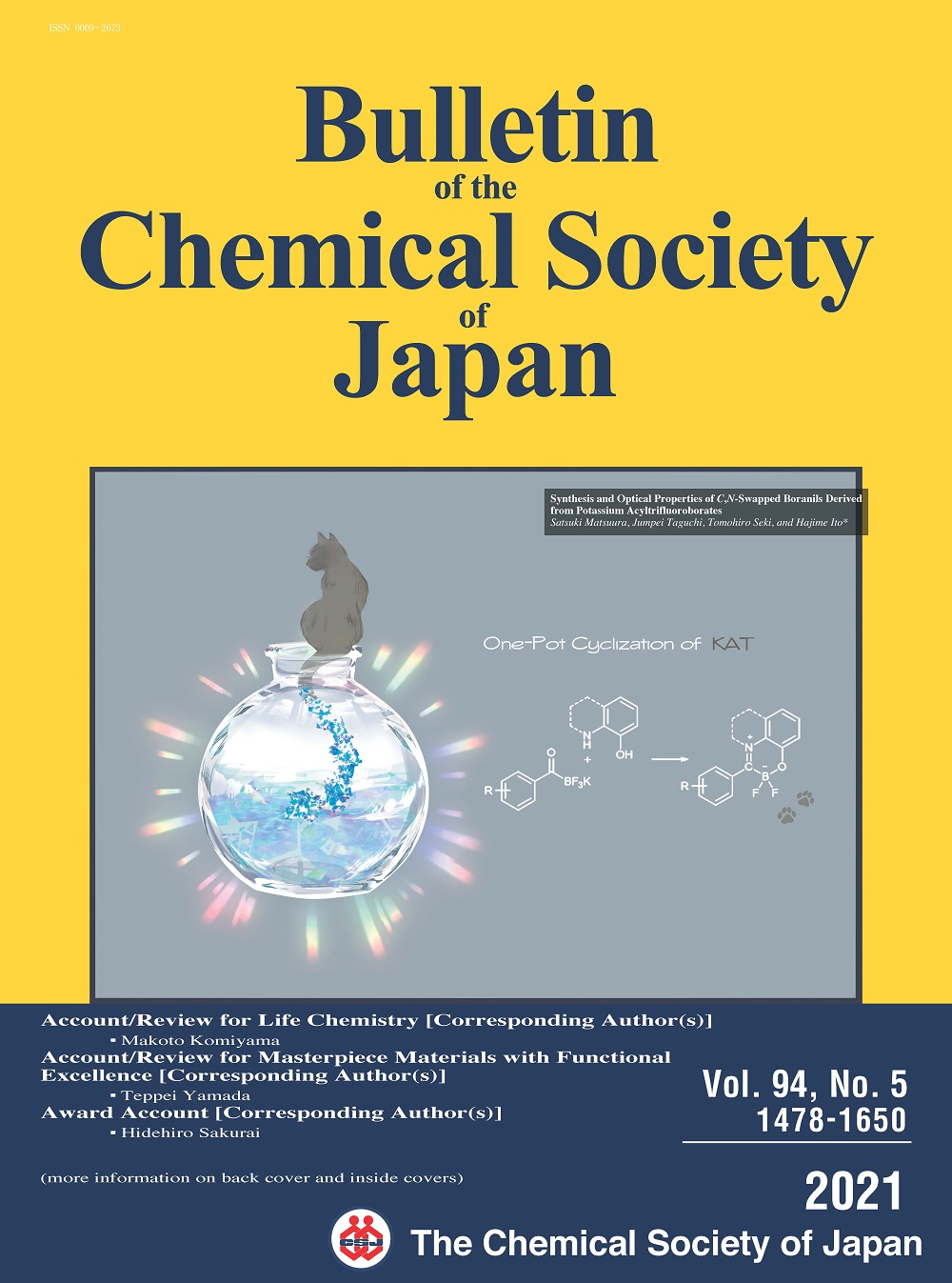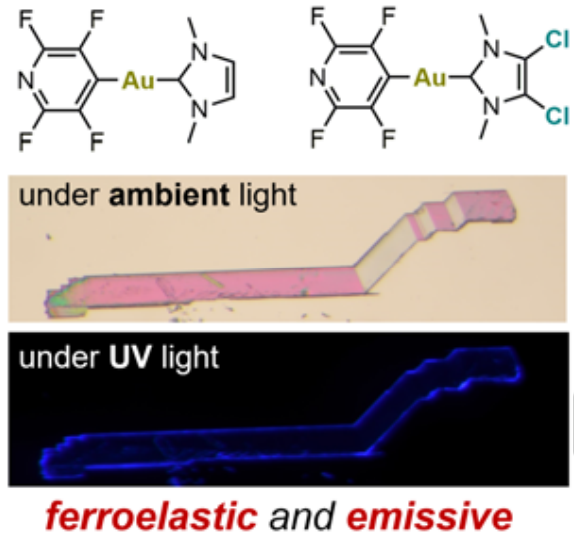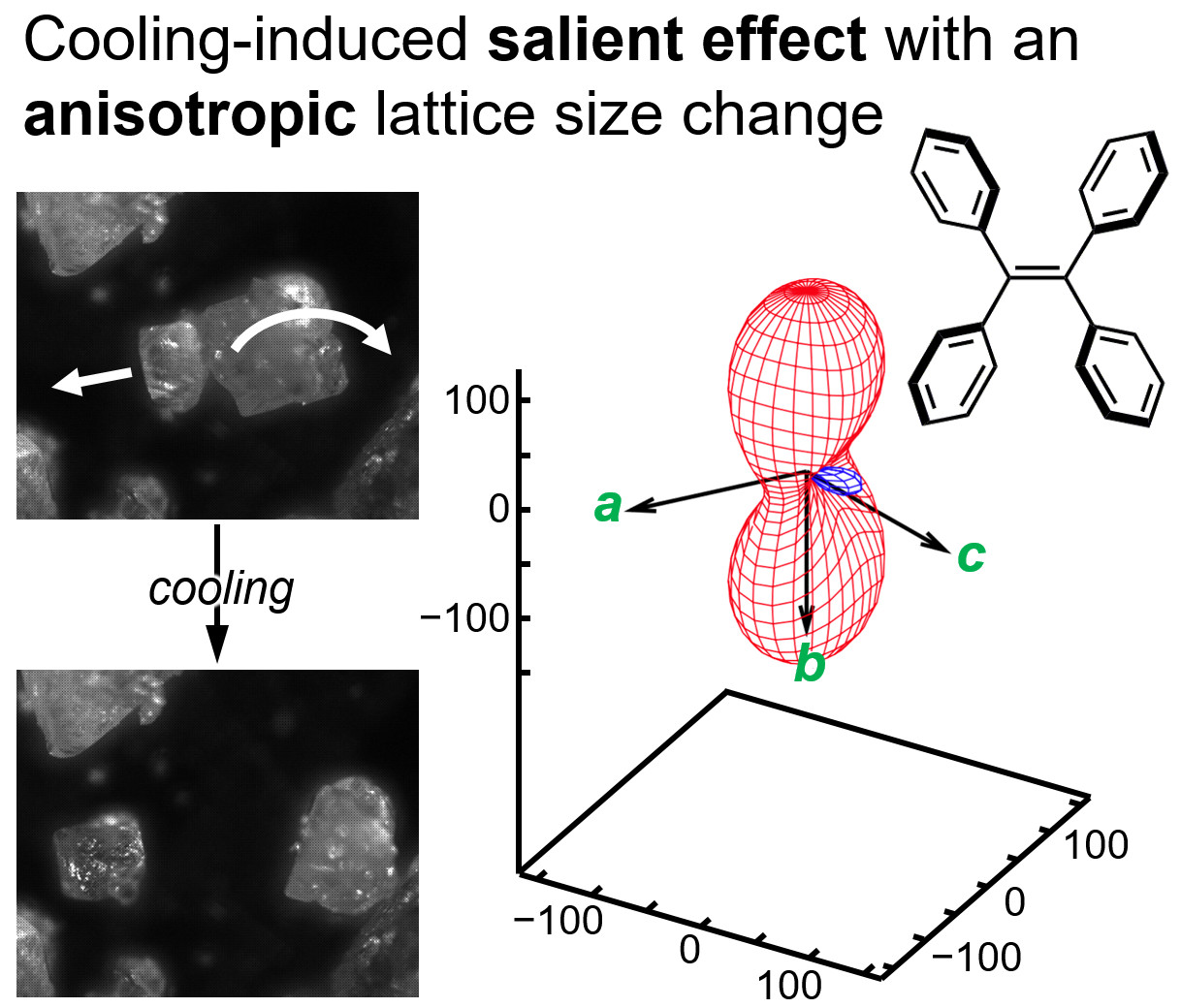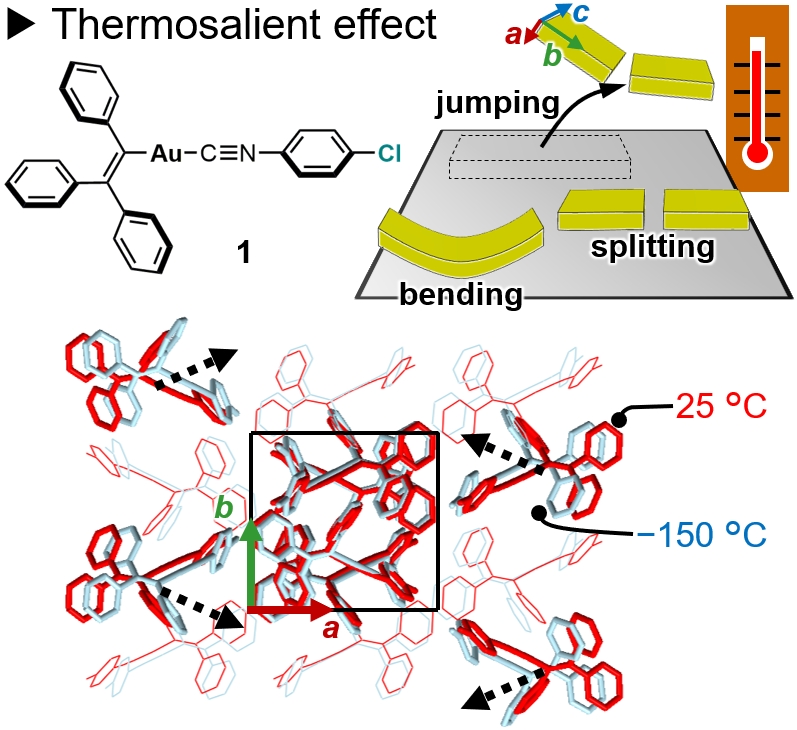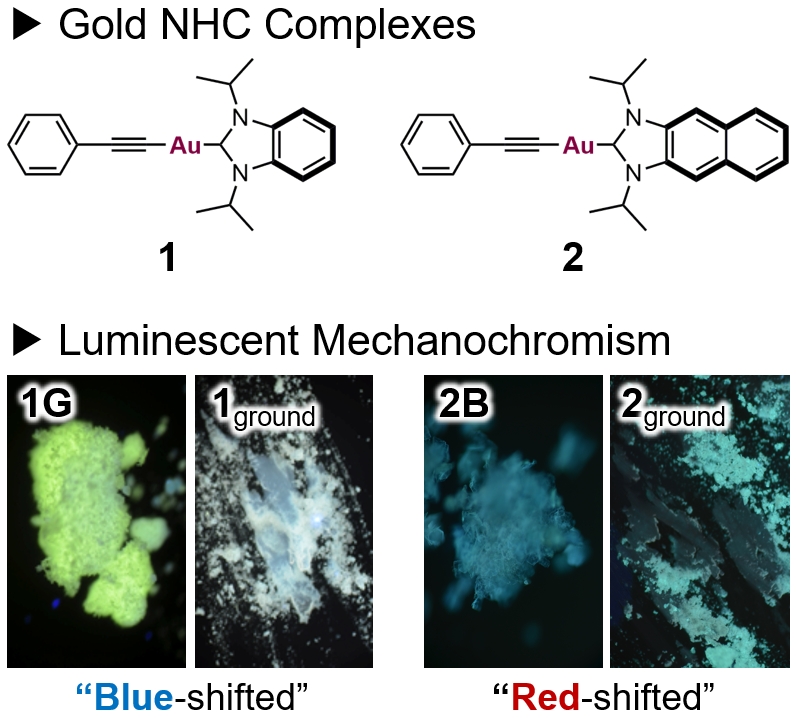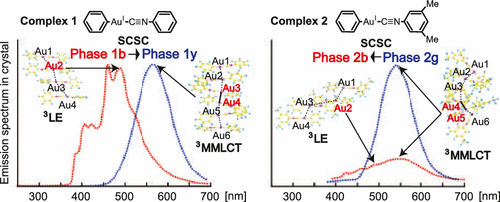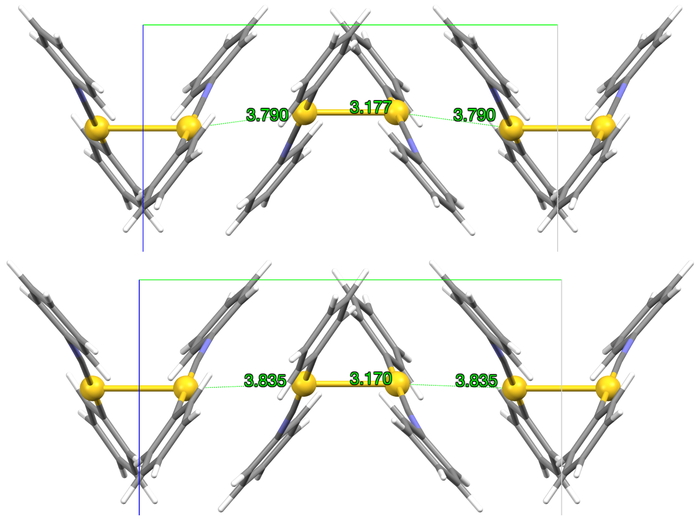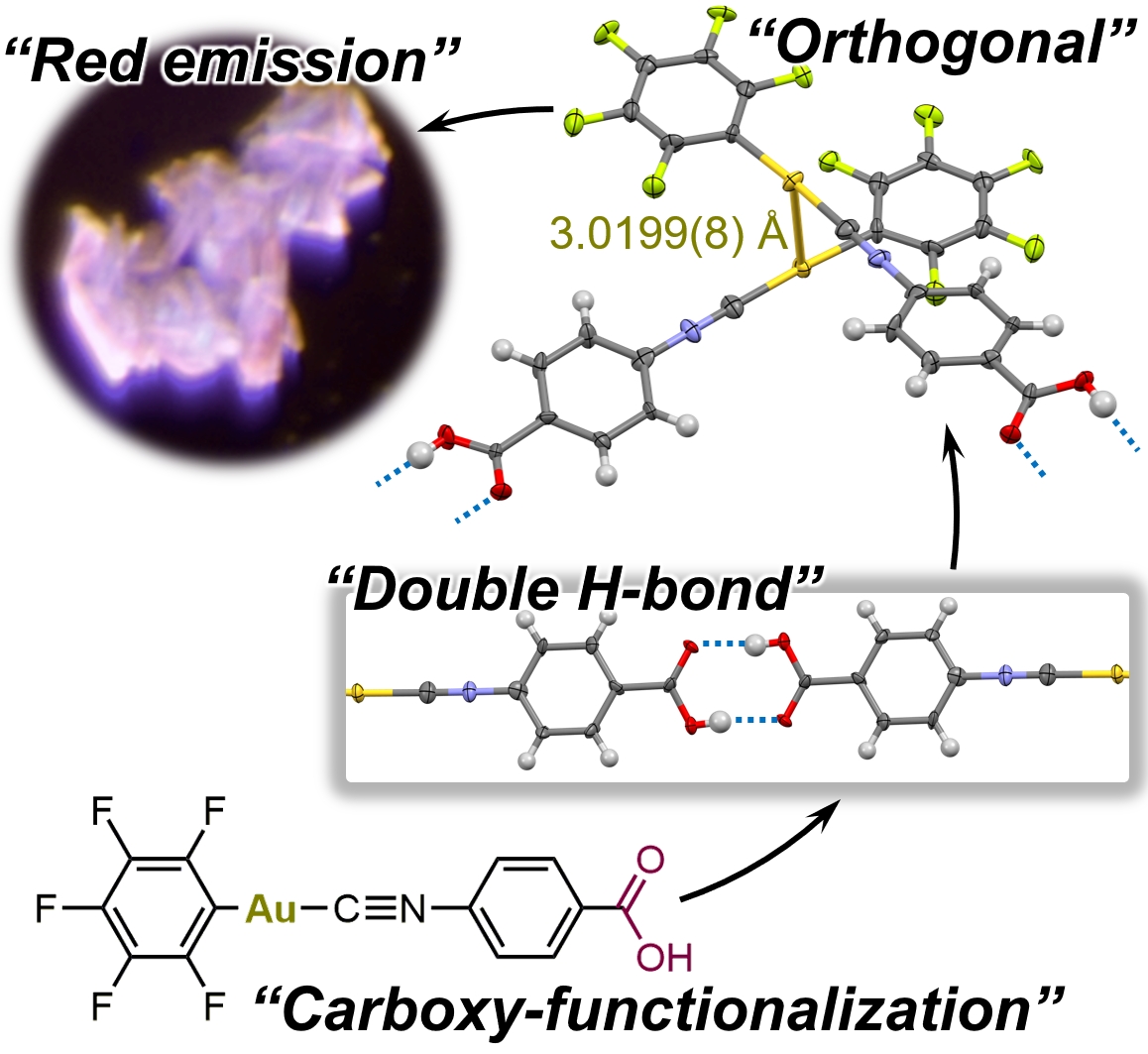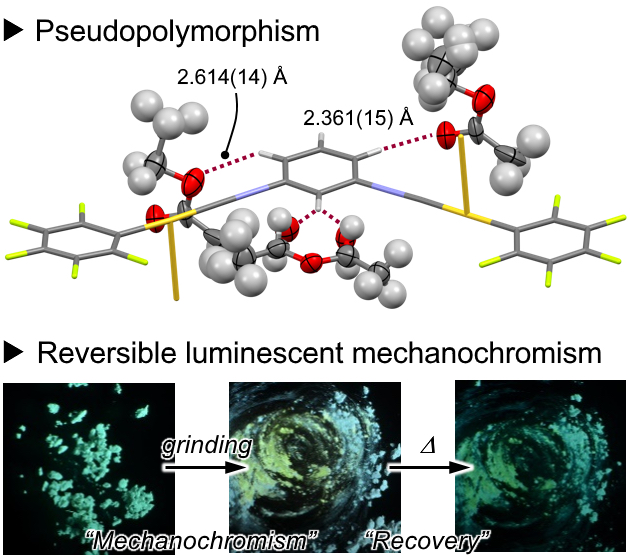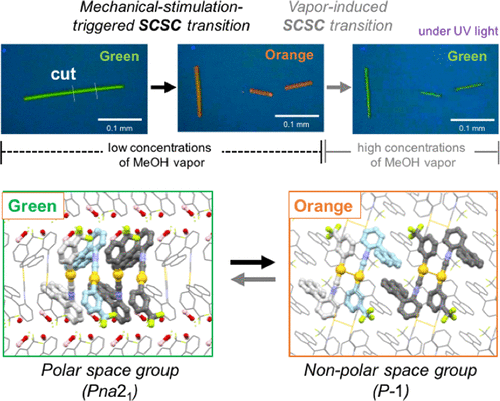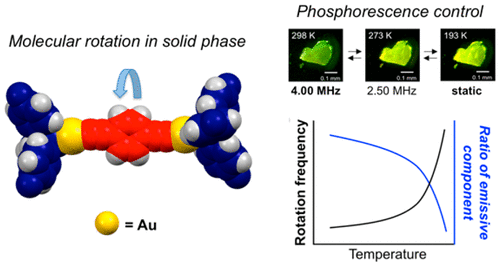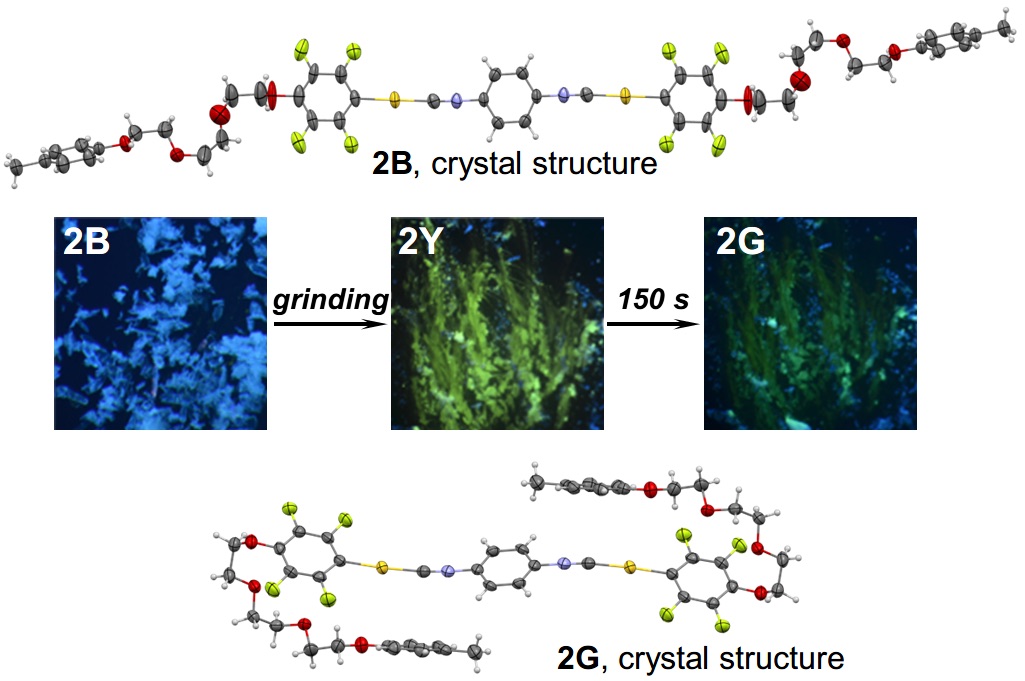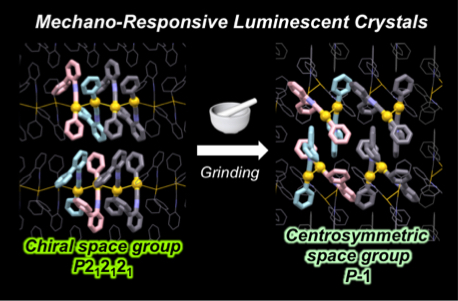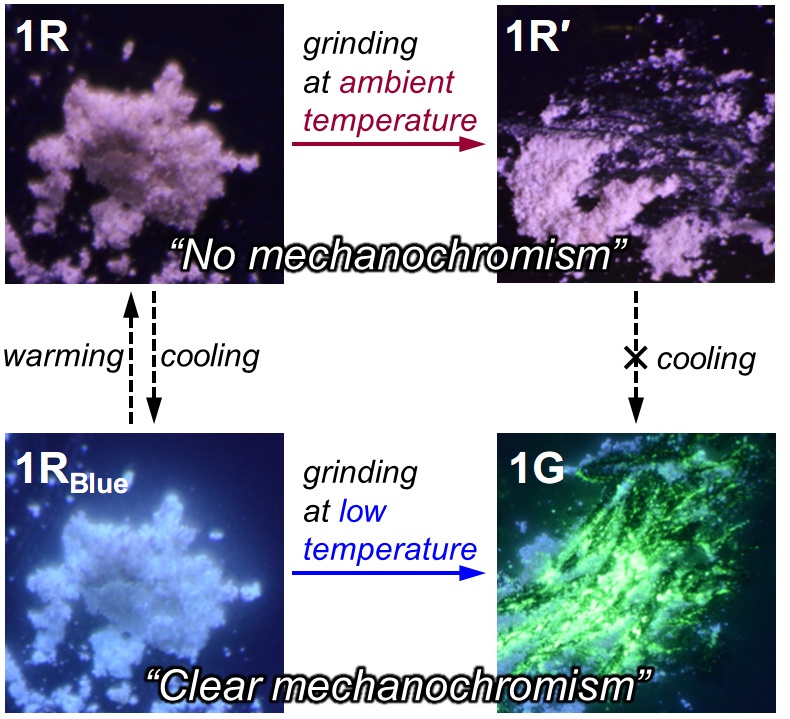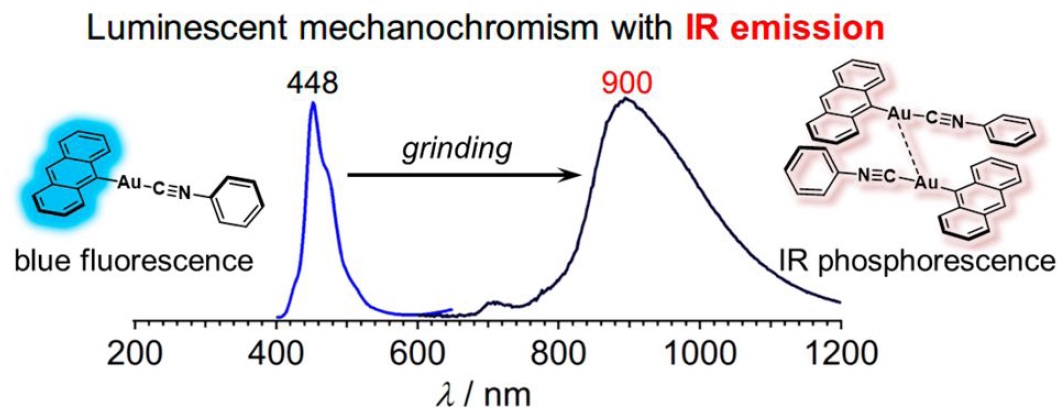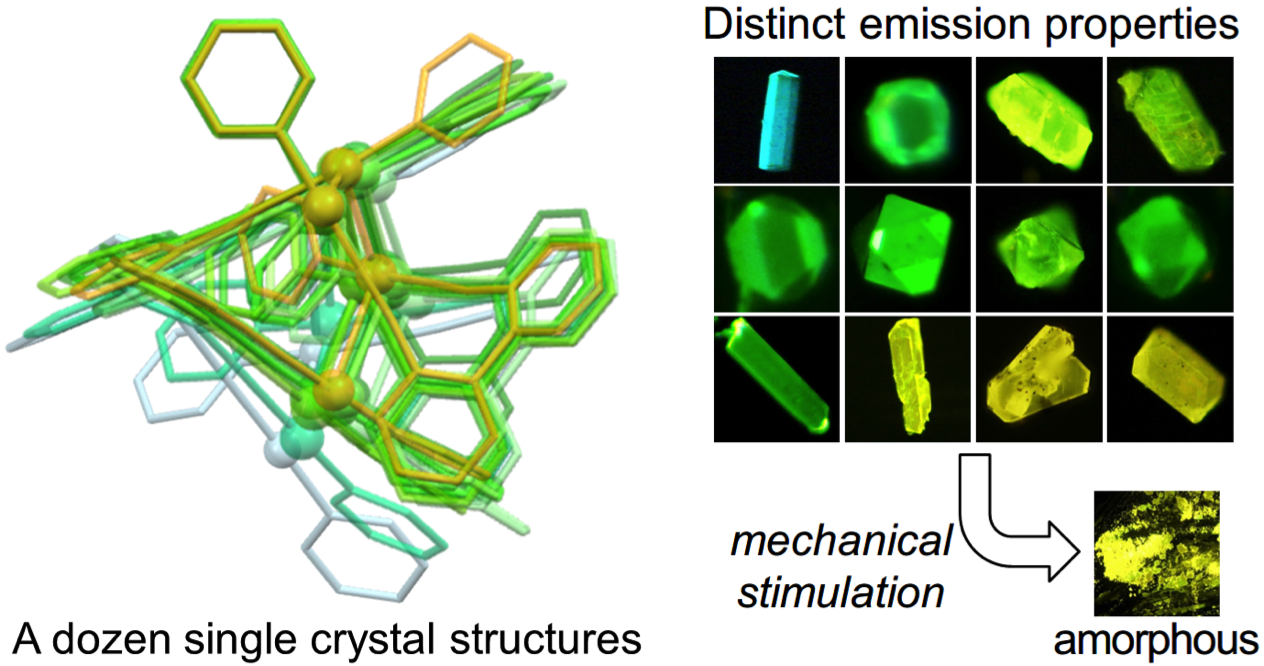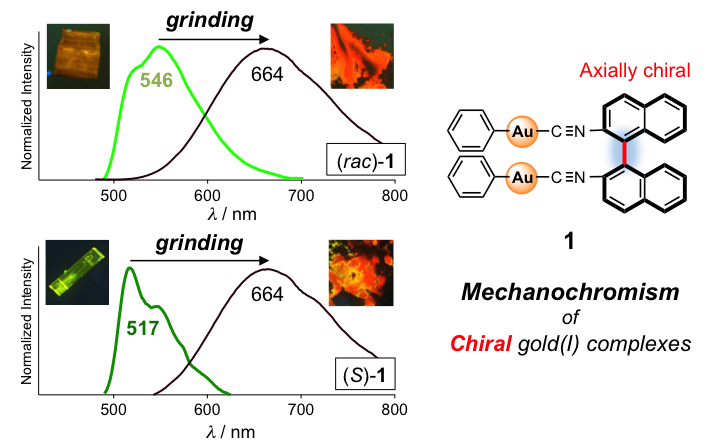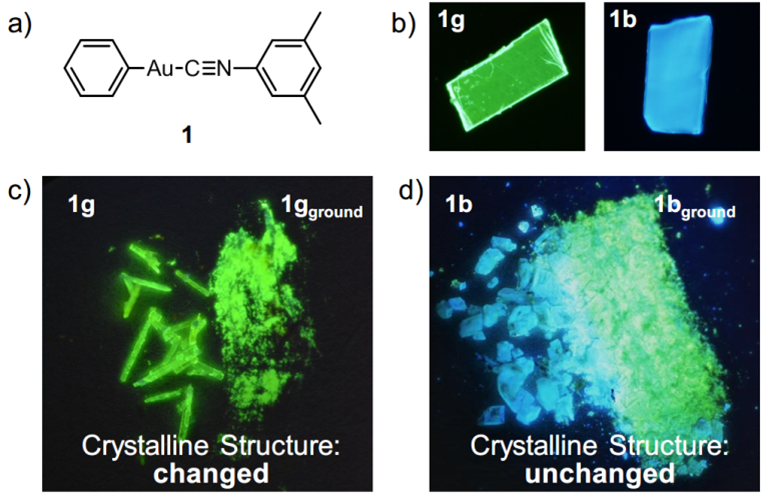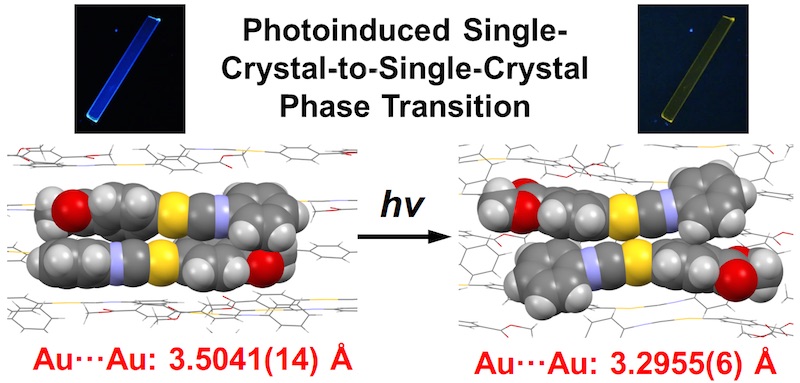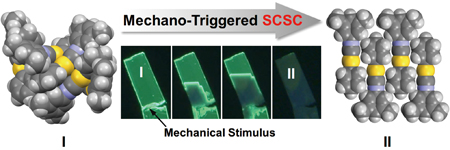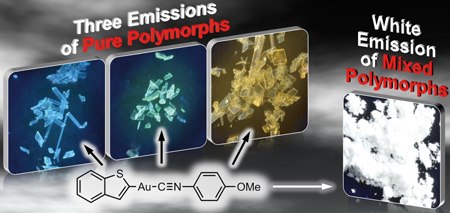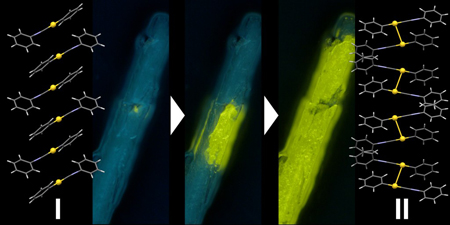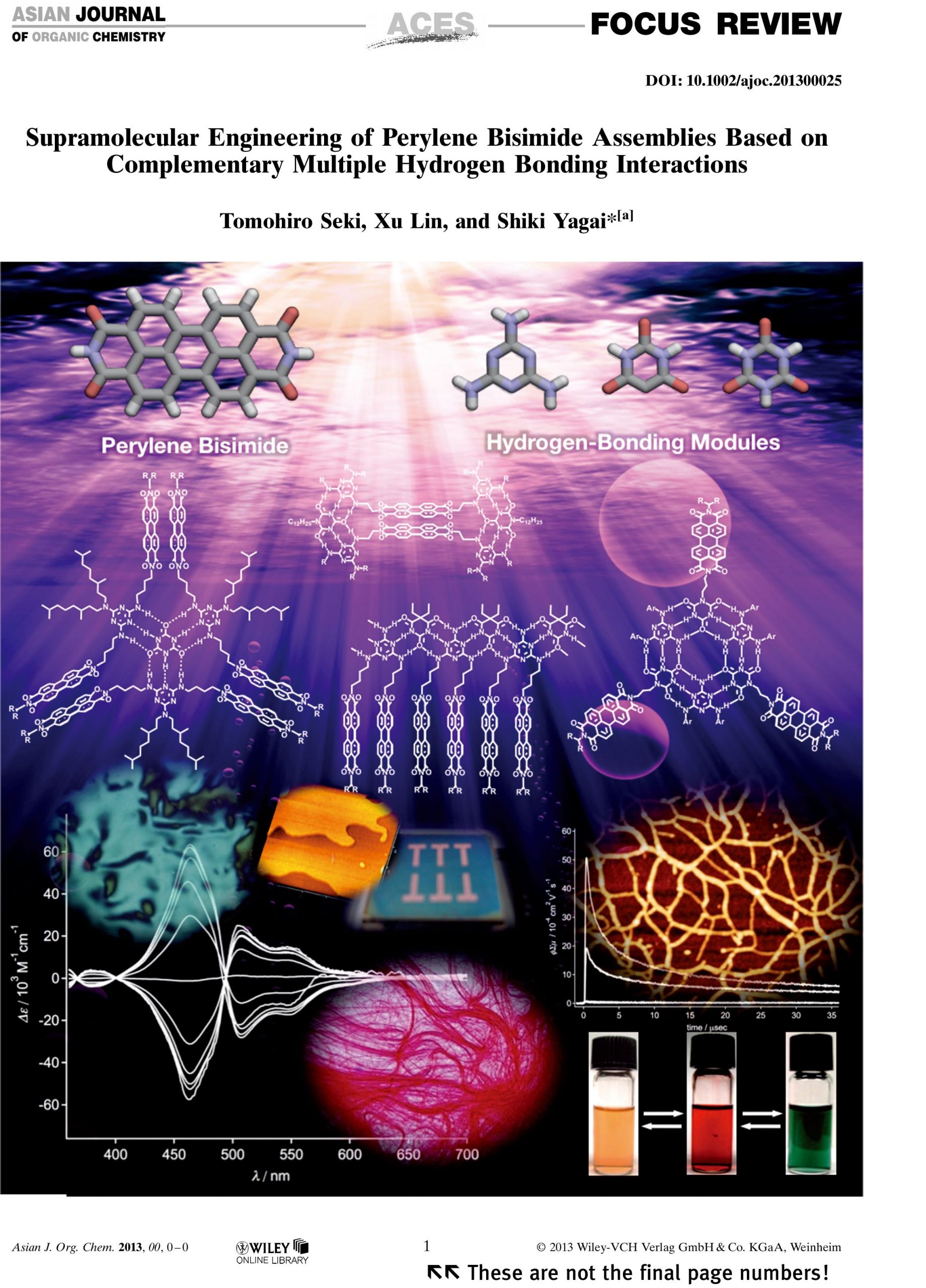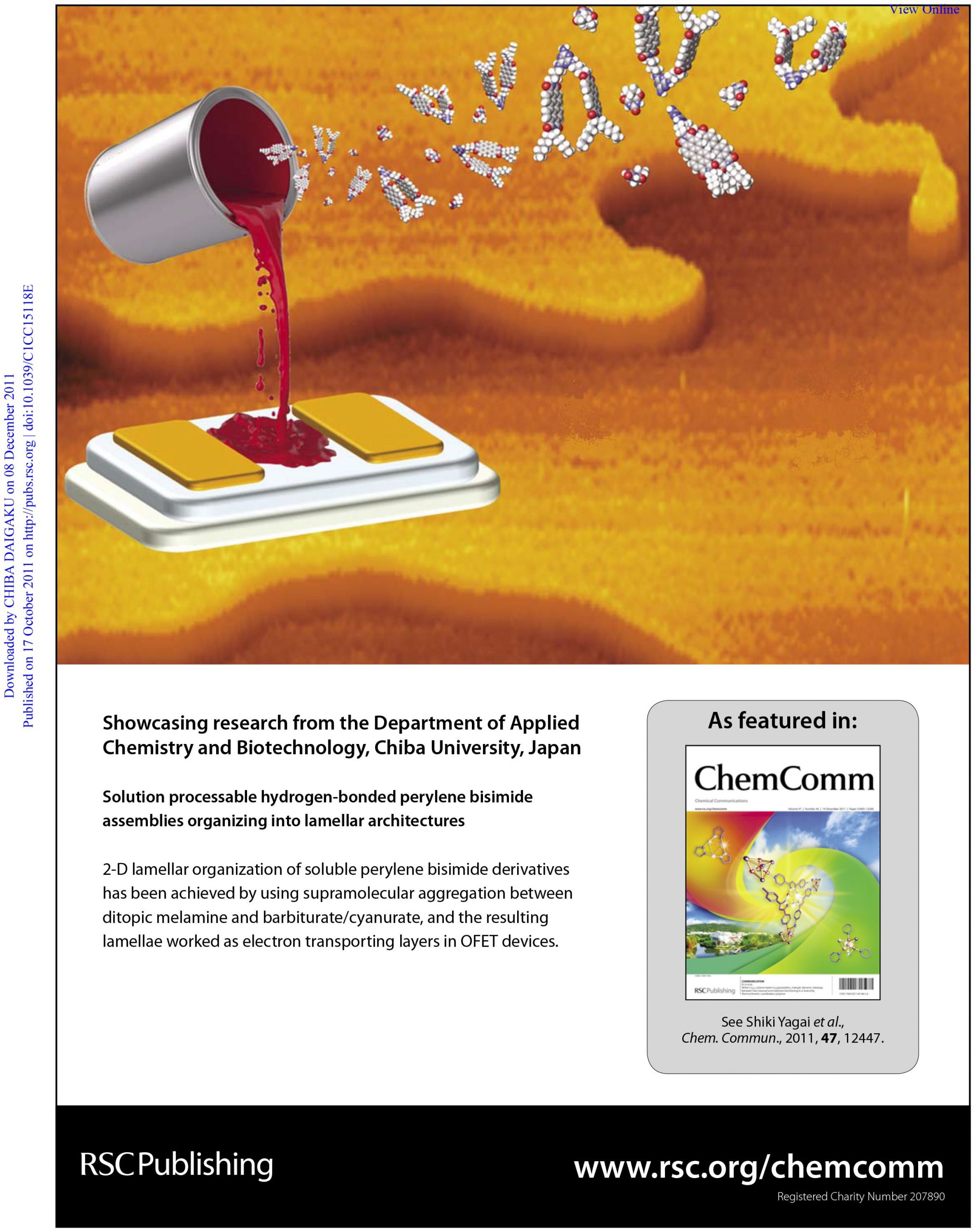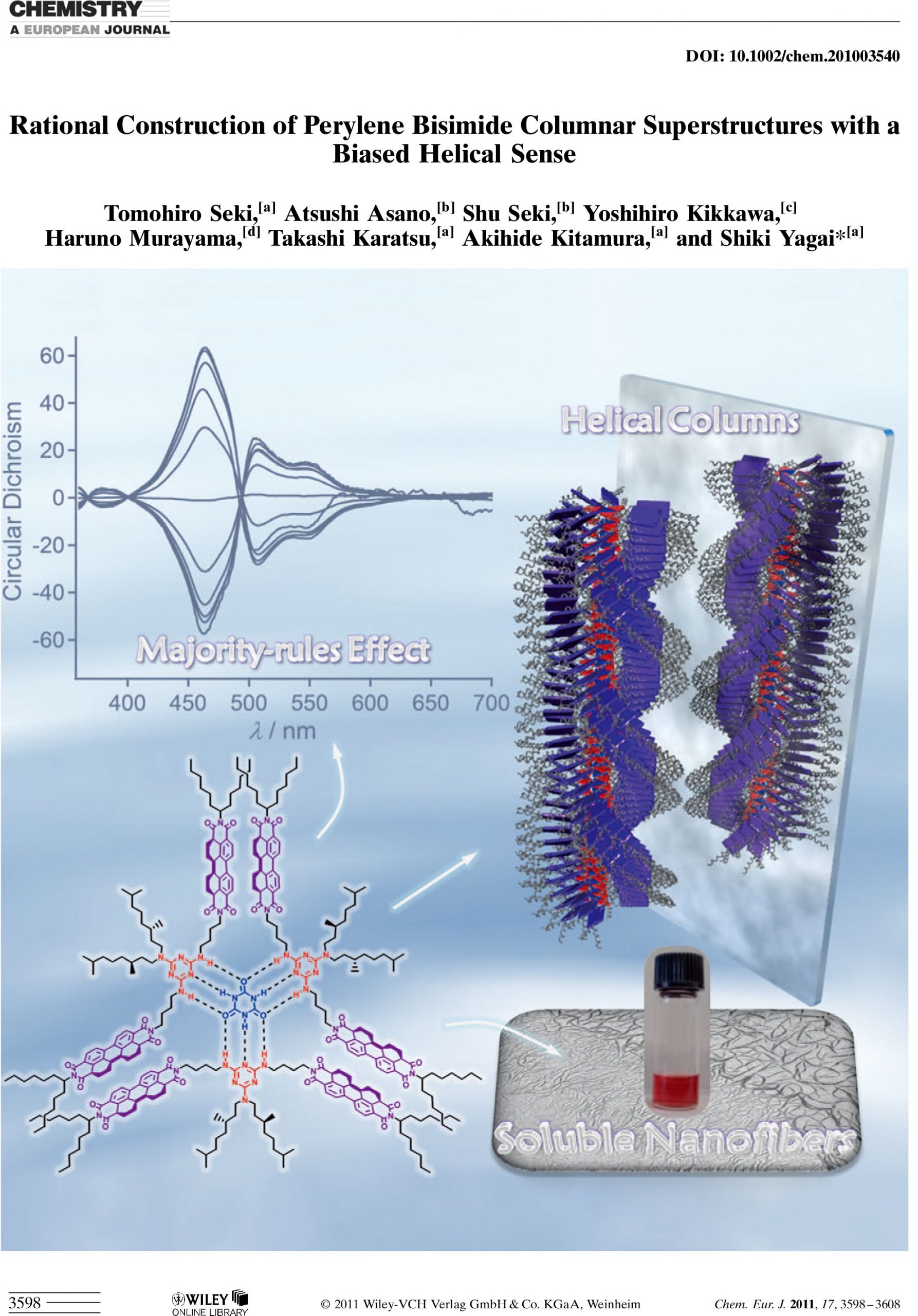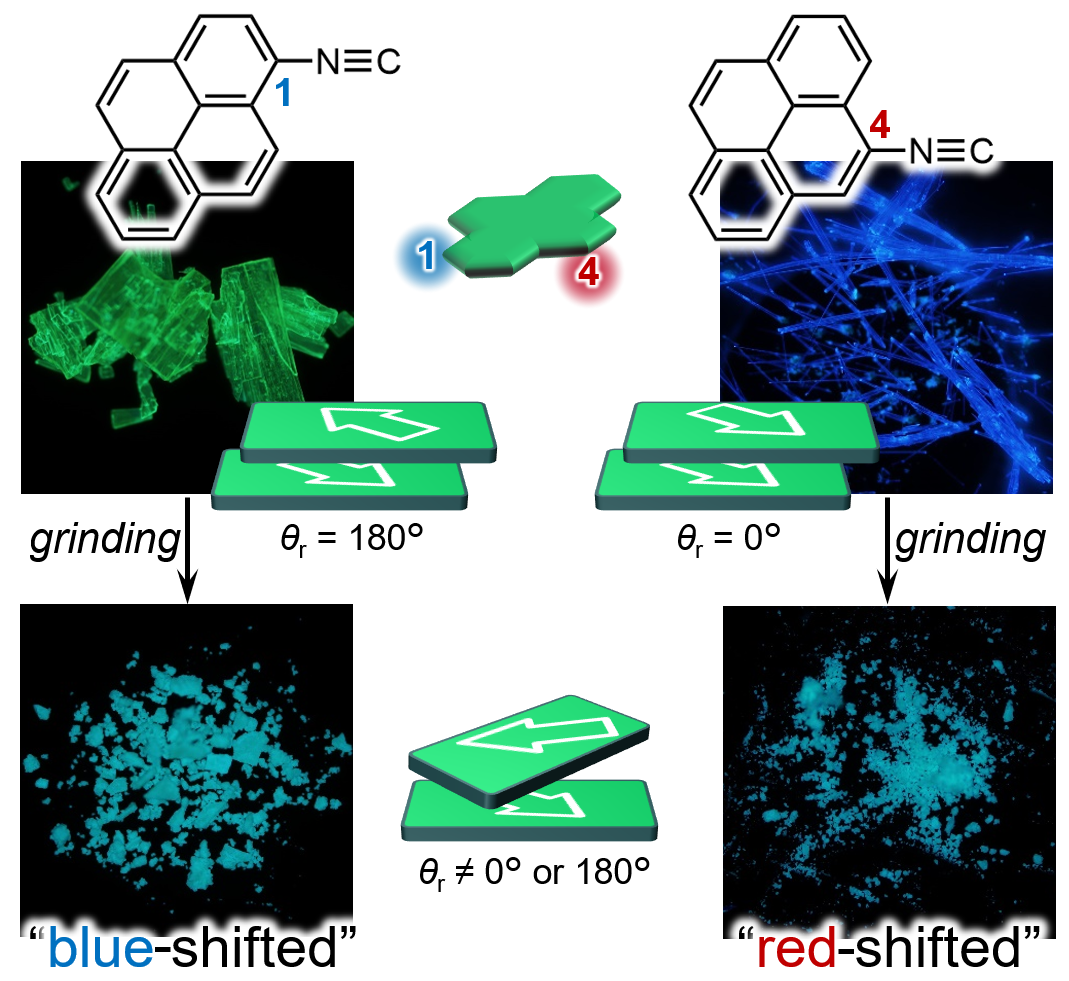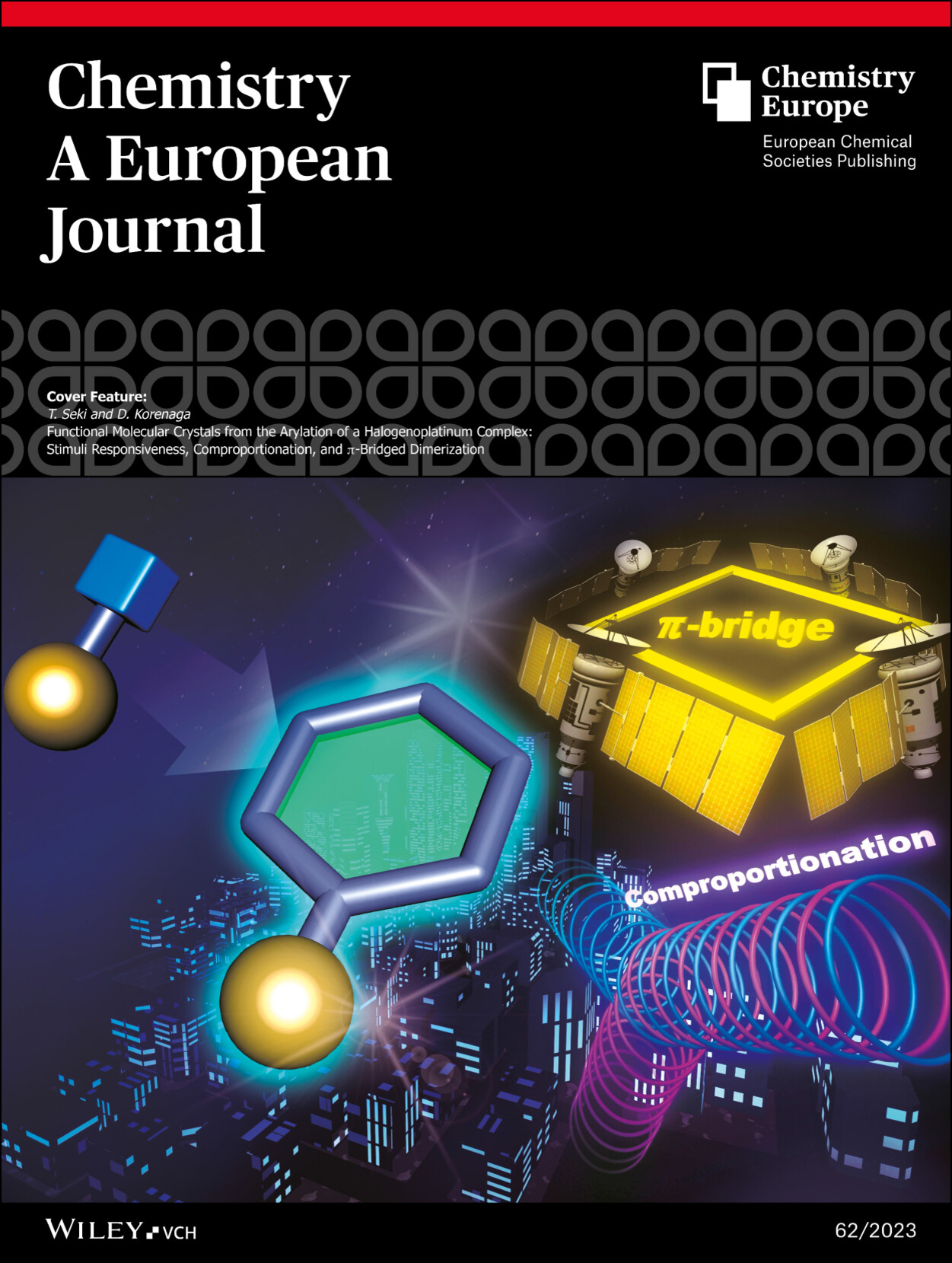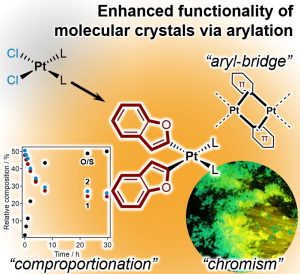2024
83. Mechanochromic aromatic hydrocarbons that bear one simple substituent,T. Seki, K. Hattori,
RSC Adv.,
2024,
14, 11, 7258–7262
DOI:
10.1039/d3ra08519h.
2023
82. Functional Molecular Crystals from the Arylation of a Halogenoplatinum Complex: Stimuli-Responsiveness, Comproportionation, and π-Bridged Dimerization, T. Seki, D. Korenaga,
Chem. Eur. J.,
2023,
29, 62, e202302333
DOI:
10.1002/chem.202302333.
2022
81. Mechanical Deformation and Multiple Thermal Restoration of Organic Crystals: Reversible Multi-Stage Shape-Changing Effect with Luminescence-Color Changes,C. Feng, T. Seki, S. Sakamoto, T. Sasaki, S. Takamizawa, H. Ito,
Chem. Sci.,
2022,
13, 9544–9551
DOI:
10.1039/D2SC03414J.
AbstractShape-memory materials can be mechanically deformed and subsequently reverse the deformation upon changing the temperature. Shape-memory materials have attracted considerable attention for basic research and industrial applications, and polymer and alloy shape-memory materials have been well studied; however, it is formidably challenging to develop functional shape-memory materials, such as materials with multi-stage and anisotropic shape changes and shape changes accompanied by changes in color and light emission. Here, we found a reversible multi-stage shape-changing effect after mechanical deformation in a molecular crystal induced by multi-step thermal phase transitions with reversible shape changes and luminescence-color changes. Using single-crystal structure and thermal analyses as well as mechanical property measurements, we found that the reversible multi-stage shape-changing effect was achieved by a combination of a twinning deformation and multi-step thermal phase transitions. The changes in the crystal shape and luminescence suggest novel strategies for imparting known shape-memory materials with additional functionalities.
2021
80. Functional Flexible Molecular Crystals: Intrinsic and Mechanoresponsive Properties,T. Seki, N. Hoshino, Y. Suzuki, S. Hayashi,
CrystEngComm,
2021,
23, 5686–5696
DOI:
10.1039/D1CE00388G.
79. (9-Isocyanoanthracene)gold(I) Complexes Exhibiting Two Modes of Crystal Jumps by Different Structure Change Mechanisms,K. Kato, T. Seki, H. Ito,
Inorg. Chem,
2021,
60, 10849–10856
DOI:
10.1021/acs.inorgchem.1c00881.
78. Synthesis and Optical Properties of C,N-Swapped Boranils Derived from Potassium Acyltrifluoroborates,S. Matsuura, J. Taguchi, T. Seki, H. Ito,
Bull. Chem. Soc. Jpn.,
2021,
94, 1547–1552
DOI:
10.1246/bcsj.20210024.
2020
77. Thermosalience in Macrocycle-Based Soft Crystals via Anisotropic Deformation of Disilanyl Architecture,K. Omoto, T. Nakae, M. Nishio, Y. Yamanoi, H. Kasai, E. Nishibori, T. Mashimo, T. Seki, H. Ito, K. Nakamura, N. Kobayashi, N. Nakayama, H. Goto, H. Nishihara,
J. Am. Chem. Soc.,
2020,
142, 12651–12657
DOI:
10.1021/jacs.0c03643.
AbstractWe describe here the preparation of soft crystals using disilanyl macrocycle C4 possessing four p-phenylenes circularly connected by four flexible disilane bonds. Single crystals of C4 exhibited a reversible thermal single-crystal-to-single-crystal (SCSC) phase transition behavior between two crystal phases accompanied by remarkable mechanical motion (thermosalient effect), as revealed by thermal analyses and X-ray diffraction measurements. Detailed structural analyses implied that flexibility of the parallelogram disilanyl architecture and molecular packing mode via weak intermolecular interactions facilitated a concerted structural transformation (parallel crank motion) of macrocycles in the crystal, thus resulting in the SCSC phase transition accompanied by anisotropic shrinking/elongation of the cells to induce the thermosalient effect. This work explores a new area of organosilicon chemistry and presents the potential utility of disilanyl macrocycles as soft crystals.
76. Hydrogen Bond-Directed Supramolecular Polymorphism Leading to Soft and Hard Molecular Ordering,T. Aizawa, K. Aratsu, S. Datta, T. Mashimo, T. Seki, T. Kajitani, F. Sillye, S. Yagai,
Chem. Commun.,
2020,
56, 4280–4283
DOI:
10.1039/D0CC01636E.
AbstractTransformation of metastable supramolecular stacks of hydrogen-bonded rosettes composed of an ester-containing barbiturated naphthalene into crystalline nanosheets occurs through the rearrangement of hydrogen-bonding patterns. The involvement of the ester group in the crystalline hydrogen-bonded pattern is demonstrated, guiding us to a new molecular design that can afford supramolecular polymorphs with soft and hard molecular packing.
75. Photoluminescent Ferroelastic Molecular Crystals,T. Seki, C. Feng, K. Kashiyama, S. Sakamoto, Y. Takasaki, T. Sasaki, S. Takamizawa, H. Ito,
Angew. Chem., Int. Ed.,
2020,
59, 8839–8843
DOI:
10.1002/anie.201914610.
AbstractFerroelasticity has been reported for several types of molecular crystals, which show mechanical‐stress‐induced shape change under twinning and/or spontaneous formation of strain. Aiming to create materials that exhibit both ferroelasticity and light‐emission characteristics, we discovered the first examples of ferroelastic luminescent organometallic crystals. Crystals of arylgold(I)(N‐heterocyclic carbene)(NHC) complexes bend upon exposure to anisotropic mechanical stress. X‐ray diffraction analyses and stress‐strain measurements on these ferroelastic crystals confirmed typical ferroelastic behavior, mechanical twinning, and the spontaneous build‐up of strain. A comparison with single‐crystal structures of related gold‐NHC complexes that do not show ferroelasticity shed light on the structural origins of the ferroelastic behavior.
74. Mixed crystal formation of two gold isocyanide complexes with various ratios for continuous tuning of photophysical properties,T. Seki, N. Toyoshima, H. Ito,
Dalton Trans.,
2020,
49, 2073–2076
DOI:
10.1039/D0DT00195C.
AbstractMixed crystals composed of two distinct gold isocyanide complexes are reported. Characterization of the mixed crystal formation and mixing ratios are performed by single-crystal X-ray diffraction and nuclear magnetic resonance spectroscopy analyses. By changing the mixing ratio, we achieve continuous changes in the emission lifetimes and the emission quantum yields.
73. Synthesis and Tunable Optical Properties of C,N-Chelated Borate Luminophores Derived from Potassium Acyltrifluoroborates,J. Taguchi, S. Matsuura, T. Seki, H. Ito,
Chem. Eur. J.,
2020,
26, 2450–2455
DOI:
10.1002/chem.201904983.
AbstractA new class of borate luminophores has been synthesized by a simple two‐step reaction using potassium acyltrifluoroborates (KATs) as starting materials. The hydrazones obtained from reactions between KATs and 2‐hydrazinopyridines followed by a cyclization resulted in the unprecedented formation of C,N‐chelated six‐membered bora‐heterocycles. Under consideration of the results of DFT and TD‐DFT calculations, four luminophores based on such bora‐heterocycles are designed and synthesized, which exhibit a tunable fluorescence range from blue to red in the solid state. Moreover, one of the luminophores exhibits mechanofluorochromism from blue to yellow/green. As a result of the aforementioned mechanochromism of one of these luminophores, white‐color emission was achieved by simply mixing the four luminophores.
72. Stacked Nanocarbon Photosensitizer for Efficient Blue Light Excited Eu(III) Emission,Y. Kitagawa, F. Suzue, T. Nakanishi, K. Fushimi, T. Seki, H. Ito, Y. Hasegawa,
Commun. Chem.,
2020,
3, 3
DOI:
10.1038/s42004-019-0251-z.
AbstractPhotosensitizer design to allow effective use of low-energy light is important for developing photofunctional materials. Herein, we describe a rational photosensitizer design for effective use of low-energy light. The developed photosensitizer is a stacked nanocarbon based on a rigid polyaromatic framework, which allows efficient energy transfer from the low-energy T1 level to the energy acceptor. We prepared an Eu(III) complex consisting of a luminescent center (Eu(III)) and stacked-coronene photosensitizer. The brightness of photosensitized Eu(III) excited using low-energy light (450 nm) is more than five times higher than the maximum brightness of previously reported Eu(III) complexes.
71. Crystal Jumping of Simple Hydrocarbons: Cooling-Induced Salient Effect of Bis-, Tri-, and Tetraphenylethene through Anisotropic Lattice Dimension Changes without Thermal Phase Transitions,T. Seki, T. Mashimo, H. Ito,
Chem. Lett.,
2020,
49, 174–177
DOI:
10.1246/cl.190768.
AbstractThe thermosalient effect of simple hydrocarbon compounds, including tetraphenylethene, is reported. Single-crystal X-ray diffraction and differential calorimetry analyses of these compounds indicate the absence of thermal phase transitions for their crystal jumps. Thermal expansion coefficient analysis indicates that anisotropic dimension changes of the crystalline lattices are important for this phenomenon.
70. Aurophilicity-mediated Construction of Emissive Porous Molecular Crystals as Versatile Hosts for Liquid and Solid Guests,T. Seki, K. Ida, H. Sato, S. Aono, S. Sakaki, H. Ito,
Chem. Eur. J.,
2020,
26, 735–744
DOI:
10.1002/chem.201904597.
2019
69. Anisotropic Thermal Expansion as the Source of Macroscopic and Molecular Scale Motion in Phosphorescent Amphidynamic Crystals,M. Jin, S. Yamamoto, T. Seki, H. Ito, M.A. Garcia-Garibay,
Angew. Chem. Int. Ed.,
2019,
58, 18003–18010
DOI:
10.1002/anie.201909048.
AbstractHerein we report a crystalline molecular rotor with rotationally modulated triplet emission that displays macroscopic dynamics in the form of crystal moving and/or jumping, also known as salient effects. Molecular rotor 2 with a central 1,4‐diethynyl‐2,3‐difluorophenylene rotator linked to two gold(I) nodes, crystalizes as infinite 1D chains through intermolecular gold(I)–gold(I) interactions. The rotational motion changes the orientation of the central phenylene, changing the electronic communication between adjacent chromophores, and thus the emission intensities. Crystals of 2 showed the large and reversible thermal expansion/compression anisotropy, which accounts for 1) a nonlinear Arrhenius behavior in molecular‐level rotational dynamics, which correlates with 2) changes in emission, and determines 3) the macroscopic crystal motion. A molecular rotor analogue 3 has properties similar to those of 2, suggesting a generalized way to control mechanical properties at molecular and macroscopic scales.
68. The Direct Dimesitylborylation of Benzofuran Derivatives via an Iridium-Catalyzed C–H Activation with Silyldimesitylborane,R. Shishido, I. Sasaki, T. Seki, T. Ishiyama, H. Ito,
Chem. Eur. J.,
2019,
25, 12924 – 12928
DOI:
10.1002/chem.201903776.
AbstractDirect dimesitylborylation of benzofuran derivatives by a C−H activation catalyzed by an iridium(I)/N‐heterocyclic carbene (NHC) complex in the presence of Ph2MeSi‐BMes2 afforded the corresponding dimesitylborylation products in good to high yield with excellent regioselectivity. This method provides a straightforward route to donor–(π‐spacer)–acceptor systems with intriguing solvatochromic luminescence properties.
67. Near-IR Luminescent YbIII Coordination Polymers Composed of Pyrene Derivatives for Thermostable Oxygen Sensors,Y. Hasegawa, T. Matsui, Y. Kitagawa, T. Nakanishi, T. Seki, H. Ito, Y. Nakasaka, T. Masuda, K. Fushimi,
Chem. Eur. J.,
2019,
25, 12308–12315
DOI:
10.1002/chem.201902583.
AbstractOxygen‐sensitive and near‐infrared (NIR) luminescent YbIII coordination polymers incorporating ligands based on pyrene derivatives were synthesized: YbIII–TBAPy and YbIII–TIAPy (TBAPy: 1,3,6,8‐tetrakis(p‐benzoate)pyrene; TIAPy: 1,3,6,8‐tetrakis(3,5‐isophthalic acid)pyrene). The coordination structures of these materials have been characterized by means of electrospray ionization mass spectrometry, X‐ray diffraction analysis, and thermogravimetric analysis. Moreover, the porous structure of YbIII–TIAPy has been evaluated by measuring its N2 adsorption isotherm. The NIR luminescence properties of YbIII–TBAPy and YbIII–TIAPy have been examined by acquiring emission spectra and determining emission lifetimes under air or argon and in vacuo. YbIII–TIAPy exhibited high thermal stability (with a decomposition temperature of 400 °C), intense luminescence (with an emission quantum yield under argon of 6.6 %), and effective oxygen‐sensing characteristics. These results suggest that NIR luminescent YbIII coordination polymers prepared using pyrene derivatives could have applications in novel thermo‐stable oxygen sensors.
66. Anisotropic strain release in a thermosalient crystal: Correlation between the microscopic orientation of molecular rearrangements and the macroscopic mechanical motion,T. Seki, T. Mashimo, H. Ito,
Chem. Sci.,
2019,
10, 4185–4191
DOI:
10.1039/C8SC05563G.
AbstractTwo gold N-heterocyclic carbene complexes show contrasting luminescent mechanochromism behavior with hypso- and bathochromic spectral shifts. The distinct emission shifts upon mechanical stimulation can be explained by the aggregate-to-monomer transformation and intensified intermolecular interactions, respectively.
65. Luminescent mechanochromism of gold N-heterocyclic carbene complexes with hypso- and bathochromic spectral shifts,T. Seki, K. Kashiyama, H. Ito,
Dalton Trans.,
2019,
48, 7105–7109
DOI:
10.1039/C9DT00566H.
AbstractTwo gold N-heterocyclic carbene complexes show contrasting luminescent mechanochromism behavior with hypso- and bathochromic spectral shifts. The distinct emission shifts upon mechanical stimulation can be explained by the aggregate-to-monomer transformation and intensified intermolecular interactions, respectively.
64. Dependence of Absorption and Emission Spectra on Polymorphs of Gold(I) Isocyanide Complexes: Theoretical Study with QM/MM Approach,S. Aono, T. Seki, H. Ito, S. Sakaki,
J. Phys. Chem. C.,
2019,
123, 4773–4794
DOI:
10.1021/acs.jpcc.8b10602.
AbstractWe theoretically investigated phenyl(phenyl isocyanide) gold(I) (PhNC)Au(Ph) 1 and phenyl(dimethylphenyl isocyanide) gold(I) (dimPhNC)Au(Ph) 2 in crystal using our periodic quantum mechanics/molecular mechanics (QM/MM) method based on the self-consistent point charges to elucidate interesting mechano-chemical changes of absorption and emission spectra of 1 and 2 in crystal. To characterize 1 and 2 in crystal, their absorption and emission spectra in crystal were compared to those in gas phase and CHCl3 solvent, where a three-dimensional reference interaction site model self-consistent field (3D-RISM-SCF) was employed to incorporate solvation effect. To investigate the phosphorescence spectrum in crystal, we optimized the geometry of the molecule at the triplet state in crystal which had ground-state geometry because the population of the excited state is generally very small. The QM/MM calculations showed that 1 formed two polymorphs 1b and 1y, 2 formed two polymorphs 2b and 2g, and 1y was more stable than 1b, which agree with the experimental findings. In 1b and 2b, the ligand-to-ligand charge transfer state is the lowest-energy excited state in the absorption, and the π–π* locally excited state on the PhNC moiety is the lowest-energy triplet state in the emission. In 1y and 2g, on the other hand, the metal–metal-to-ligand charge transfer (MMLCT) state is the lowest-energy excited state in both absorption and emission. These characteristic differences between two crystal structures arise from the geometrical features that the Au–Au distance is much shorter in 1y and 2g than in 1b and 1y and the intermolecular torsion angle η between two Au-PhNC moieties is much smaller in 1y and 2g than in 1b and 2b, respectively; the short Au–Au distance raises the energy level of antibonding orbital consisting of two Au dσ orbitals, and the small η angle lowers the energy level of bonding orbital consisting of two PhNC π* orbitals, leading to the presence of a lower-energy MMLCT state. The QM/MM calculations also disclosed intramolecular torsion angle τ between the Ph and PhNC planes and CH−π interaction of the Ph plane significantly influence absorption spectrum. Based on those computational results, discussion is presented on the differences in absorption and emission spectra among gas, solution, and crystal, the assignments of experimentally observed excitation and emission spectra in crystal, and their energy shifts induced by single-crystal-to-single-crystal phase transition.
2018
63. Soft Crystal Force Field for Reproducing the Crystal Structures of Aryl Gold Isocyanide Complexes,N. Nakayama, S. Obata, Y. Hori, H. Goto, T. Seki, H. Ito,
J. Comput. Chem. Jpn.,
2018,
17, 155–157
DOI:
10.2477/jccj.2018-0031.
AbstractForce field parameters around Au atom that have been lacking in standard parameter set of the MMFF94s were temporarily determined to reproduce the molecular crystal structure of phenyl(phenylisocyanide)gold(I) complex by classical force field calculations. It was confirmed that two polymorphic forms optimized by CONFLEX software with these parameters are in good agreement with the experimental structures. Application of the parameters to other derivatives also gives good results but the Au..Au distances in some crystal structures are longer than those of the experimental. Therefore, further optimization of these parameters will be required.
62. Structural Manipulation of Triboluminescent Lanthanide Coordination Polymers by Side-Group Alteration,Y. Hirai, P. P. F. Da Rosa, T. Nakanishi, Y. Kitagawa, K. Fushimi, T. Seki, H. Ito, Y. Hasegawa,
Inorg. Chem.,
2018,
57, 14653–14659
DOI:
10.1021/acs.inorgchem.8b02367.
61. Synthesis and Evaluation of 1,3a,6a-Triazapentalene (TAP)-Bonded System,M. Ito, A. Mera, T. Mashimo, T. Seki, S. Karanjit, E. Ohashi, A. Nakayama, K. Kitamura, T. Hamura, H. Ito, K. Namba,
Chem. Eur. J.,
2018,
24, 17727–17733
DOI:
10.1002/chem.201804733.
AbstractA method of synthesizing a directly connected 1,3a,6a‐triazapentalene (TAP) ring system as a linearly bonded aromatic system with a planar form was established. Various TAP‐dimers and a 2‐alkyl‐TAP‐trimer were synthesized and their fluorescence properties were evaluated. Although the direct connection of the TAP ring with other TAP rings did not affect the fluorescence properties in diluted solvent, TAP‐dimers showed unique fluorescence properties derived from the aggregation state under highly concentrated conditions. In particular, TAP‐dimer 5 f showed aggregation‐induced emission in highly concentrated solution, and 5 b showed typical mechanochromic fluorescence in the solid state despite their compact molecular size.
60. A Gold Isocyanide Complex with a Pendant Carboxy Group: Orthogonal Molecular Arrangements and Hypsochromically Shifted Luminescent Mechanochromism,T. Seki, K. Kobayashi, T. Mashimo, H. Ito,
Chem. Commun.,
2018,
54, 13160–13160
DOI:
10.1039/C8CC06490C.
AbstractCorrection: A gold isocyanide complex with a pendant carboxy group: orthogonal molecular arrangements and hypsochromically shifted luminescent mechanochromism
https://pubs.rsc.org/en/content/articlelanding/2018/cc/c8cc90488j
The epistatic double hydrogen bonds that arise from the presence of a pendant carboxy group in a gold isocyanide complex result in strong aurophilic interactions in a magenta-emitting polymorph. This is due to the lack of the typically antiparallel dimer arrangements, which often prevent the formation of strong aurophilic interactions. Furthermore, this polymorph shows hypsochromically shifted luminescence mechanochromism.
59. Spiral Eu(III) Coordination Polymers with Circularly Polarized Luminescence,Y. Hasegawa, Y. Miura, Y. Kitagawa, S. Wada, T. Nakanishi, K. Fushimi, T. Seki, H. Ito, T. Iwasa, T. Taketsugu, M. Gon, Y. Chujo, S. Hattori, M. Karasawa, K. Ishii,
Chem. Commun.,
2018,
54, 10695–10697
DOI:
10.1039/C8CC05147J.
58. Light-Regulated Crystal Growth of π-Conjugated Luminophores in an Azobenzene Matrix,T. Kobayashi, Y. Kitamoto, Y. Hirai, T. Kajitani, T. Seki, S. Yagai,
Commun. Chem.,
2018,
1, 58
DOI:
10.1038/s42004-018-0061-8.
57. Spin-orbit Coupling Dependent Energy Transfer in Luminescent Nonanuclear Yb-Gd / Yb-Lu Clusters,S. Omagari, T. Nakanishi, Y. Kitagawa, T. Seki, K. Fushimi, A. Meijerink, Y. Hasegawa,
J. Lumin.,
2018,
201, 170–175
DOI:
10.1016/j.jlumin.2018.04.049.
56. meta-diisocyanide benzene-based aryl gold isocyanide complex exhibiting multiple solid-state molecular arrangements and luminescent mechanochromism,T. Seki, K. Ida, H. Ito,
Mater. Chem. Front.,
2018,
2, 1195–1200
DOI:
10.1039/C8QM00074C.
AbstractFunctional organic solids with switchable photoluminescence properties in response to external stimulation have attracted much interest because of their potential applications in sensors and imaging devices. Among these organic solids, luminescent mechanochromic compounds are emerging materials that can switch their photoluminescence properties when mechanically perturbed. Our group has intensively studied the solid-state emission properties and luminescent mechanochromism of a series of aryl gold isocyanide complexes. Here, we prepared bent-shaped binuclear gold isocyanide complex 2, which exhibits different pseudopolymorphs with different emission properties when prepared using different crystallization procedures. X-ray diffraction measurements and NMR spectroscopy indentified inclusion of solvent molecules in the crystalline lattices of 2 except for one polymorph. Complex 2 also shows luminescent mechanochromism based on a crystalline-to-amorphous phase transition. The ground phases of all of the pseudopolymorphs revert to the polymorph without solvent molecules upon thermal treatment.
55. Thermosensitive Luminophores Using Seven-Coordinate TbIII Complexes Based on LLCT Transition,P. P. F. Da Rosa, T. Nakanishi, Y. Kitagawa, T. Seki, H. Ito, K. Fushimi, Y. Hasegawa,
Eur. J. Inorg. Chem.,
2018, , 2031–2037
DOI:
10.1002/ejic.201800281.
54. Mechanical-Stimulation-Triggered and Solvent-Vapor-Induced Reverse Single-Crystal-to-Single-Crystal Phase Transitions with Alterations of the Luminescence Color,M. Jin, T. Sumitani, H. Sato, T. Seki, H. Ito,
J. Am. Chem. Soc.,
2018,
140, 2875–2879
DOI:
10.1021/jacs.7b12455.
AbstractLuminescence alterations in solid-state materials upon external stimulations have attracted much attention due to their potential for the development of highly functional devices or sensors. We have previously reported the first examples of mechano-induced single-crystal-to-single-crystal (SCSC) phase transitions of gold(I) isocyanide complexes under concomitant emission-color changes. However, the reverse phase transitions of the crystals obtained after mechanical stimulation have not yet been achieved. Herein, a reversible change of the luminescence based on two SCSC phase transitions via mechanical cutting and solvent-vapor adsorption is described. Crystallization of a gold(I) complex that bears CF3 and biaryl moieties from CH2Cl2/MeOH afforded a green-emitting single crystal packed in a polar space group (Pna21). The green-emitting single crystals included MeOH molecules. Upon cutting the crystal under MeOH vapor at 22 °C, the green-emitting single crystal spontaneously changed into a centrosymmetric orange-emitting single crystal (P1̅) under concomitant release of MeOH. Remarkably, the initial green-emitting crystal could be recovered from the orange-emitting crystal by a solvent-induced SCSC transition under saturated MeOH vapor. The combination of two different types of SCSC phase transitions enables the reversible structural and photoluminescent alternations.
53. A Luminescent Dinuclear EuIII/TbIII Complex with LMCT Band for Single-Molecular Thermosensor,K. Yanagisawa, Y. Kitagawa, T. Nakanishi, T. Seki, K. Fushimi, H. Ito, Y. Hasegawa,
Chem. Eur. J.,
2018,
24, 1956–1961
DOI:
10.1002/chem.201705021.
52. Synthesis and Photophysical Properties of Eu(III) Complexes with Phosphine Oxide Ligands Including Metal Ions,M. Yamamoto, T. Nakanishi, Y. Kitagawa, T. Seki, H. Ito, K. Fushimi, Y. Hasegawa,
Bull. Chem. Soc. Jpn.,
2018,
91, 6–11
DOI:
10.1246/bcsj.20170241.
51. Origin of Concentration Quenching in Ytterbium Coordination Polymers: Phonon-Assisted Energy Transfer,S. Omagari, T. Nakanishi, Y. Hirai, Y. Kitagawa, T. Seki, K. Fushimi, H. Ito, Y. Hasegawa,
Eur. J. Inorg. Chem.,
2018, , 561–567
DOI:
10.1002/ejic.201701040.
2017
50. Phosphorescence Control Mediated by Molecular Rotation and Aurophilic Interactions in Amphidynamic Crystals of 1,4-bis[tri-(p-fluorophenyl)phosphane-gold(I)-ethynyl]benzene,M. Jin, T. J. Chung, T. Seki, H. Ito, M. A. Garcia-Garibay,
J. Am. Chem. Soc.,
2017,
139, 18115 –18121
DOI:
10.1021/jacs.7b11316.
AbstractHere we present a structural design aimed at the control of phosphorescence emission as the result of changes in molecular rotation in a crystalline material. The proposed strategy includes the use of aurophilic interactions, both as a crystal engineering tool and as a sensitive emission probe, and the use of a dumbbell-shaped architecture intended to create a low packing density region that permits the rotation of a central phenylene. Molecular rotor 1, with a central 1,4-diethynylphenylene rotator linked to two gold(I) triphenylphosphane complexes, was prepared and its structure confirmed by single-crystal X-ray diffraction, which revealed chains mediated by dimeric aurophilic interactions. We showed that green-emitting crystals exhibit reversible luminescent color changes between 298 and 193 K, which correlate with changes in rotational motion determined by variable-temperature solid-state 2H NMR spin–echo experiments. Fast two-fold rotation with a frequency of ca. 4.00 MHz (τ = 0.25 μs) at 298 K becomes essentially static below 193 K as emission steadily changes from green to yellow in this temperature interval. A correlation between phosphorescence lifetimes and rotational frequencies is interpreted in terms of conformational changes arising from rotation of the central phenylene, which causes a change in electronic communication between the gold-linked rotors, as suggested by DFT studies. These results and control experiments with analogue 2, possessing a hindered tetramethylphenylene that is unable to rotate in the crystal, suggest that the molecular rotation can be a useful tool for controlling luminescence in the crystalline state.
49. Tris(trimethylsilyl)silyl Boronate Esters: Novel Bulky, Air- and Moisture-Stable Silylboronate Ester Reagents for Boryl Substitution and Silaboration Reactions,E. Yamamoto, R. Shishido, T. Seki, H. Ito,
Organometallics.,
2017,
36, 3019–3022
DOI:
10.1021/acs.organomet.7b00476.
AbstractNew, bulky tris(trimethylsilyl)silylboronate pinacol and hexylene glycol esters ((TMS)3Si–B(pin) and (TMS)3Si–B(hg)) were prepared in 46 and 61% yields, respectively, by the reaction of tris(trimethylsilyl)silylpotassium with the corresponding boron electrophiles. Notably, these silylboronate esters exhibited high stability to air and silica gel and were applied to the transition-metal-free boryl substitution of aryl halides, providing the desired borylated products in high yields with excellent B:Si ratios (up to 96% yield, B/Si = 99/1). These new silylboronate esters were also applied to a sequential borylation/cross-coupling process with various aryl halides, as well as the base-mediated silaboration of styrene.
48. Enhanced Luminescence of Asymmetrical Seven-Coordinate EuIII Complexes Including LMCT Perturbation,K. Yanagisawa, Y. Kitagawa, T. Nakanishi, T. Akama, M. Kobayashi, T. Seki, K. Fushimi, H. Ito, T. Taketsugu, Y. Hasegawa,
Eur. J. Inorg. Chem.,
2017,
2017, 3843–3848
DOI:
10.1002/ejic.201700815.
47. Tuning the Lifetime of Transient Phases of Mechanochromic Gold Isocyanide Complexes through Functionalization of the Terminal Moieties of Flexible Side Chains,T. Seki, K. Kashiyama, S. Yagai, H. Ito,
Chem. Lett.,
2017,
46, 1415–1418
DOI:
10.1246/cl.170482.
AbstractThe lifetime of the transient phases of luminescent mechanochromic gold isocyanide complexes could be tuned through the modification of the termini of flexible side chains. Upon grinding, these complexes initially showed an emission color change from blue to yellow. The yellow emission spontaneously changed to blue or green, but with different lifetimes of the yellow-emitting transient phases depending on the substituents. Details of the mechano-induced structure changes were also described.
46. Mechano-Responsive Luminescence via Crystal-to-Crystal Phase Transitions between Chiral and Non-Chiral Space Groups,M. Jin, T. Seki, H. Ito,
J. Am. Chem. Soc.,
2017,
139, 7452–7455
DOI:
10.1021/jacs.7b04073.
AbstractHerein, a novel mechano-responsive luminescent (MRL) material based on crystal-to-crystal phase transitions between crystals of a chiral and those of a centrosymmetric space group, accompanied by a change of emission properties, is described. Initially, a gold complex containing a biphenyl moiety, which exhibits an achiral structure in solution, afforded an orange-emitting amorphous phase together with a viscous isotropic oil after evaporation of the solvent. Upon pricking, the orange-emitting oil spontaneously crystallized either in a centrosymmetric or in a chiral space group while simultaneously changing the emission properties. Remarkably, grinding the chiral crystals induced a solid-state phase transition to the achiral crystals under concomitant changes of the emission properties.
45. Low-Temperature-Selective Luminescent Mechanochromism of a Thienyl Gold Isocyanide Complex,T. Seki, K. Kobayashi, H. Ito,
Chem. Commun.,
2017,
53, 6700–6703
DOI:
10.1039/C7CC03190D.
Abstract
The low-temperature-selective mechanochromism of a thienyl gold(I) isocyanide complex is reported. The as-prepared powder of this complex did not show any luminescent color changes upon grinding at room temperature. When cooled below −50 °C, the powder showed a blue emission in the absence of a phase transition. Upon grinding this powder below −50 °C, a green emission was observed, which indicates notable mechanochromism that only occurs at low temperature.
44. Luminescent Mechanochromic 9-Anthryl Gold(I) Isocyanide Complex with an Emission Maximum at 900 nm after Mechanical Stimulation,T. Seki, N. Tokodai, S. Omagari, T. Nakanishi, Y. Hasegawa, T. Iwasa, T. Taketsugu, H. Ito,
J. Am. Chem. Soc.,
2017,
139, 6514–6517
DOI:
10.1021/jacs.7b00587.
AbstractUpon mechanical stimulation, 9-anthryl gold(I) isocyanide complex 3 exhibited a bathochromic shift of its emission color from the visible to the infrared (IR) region, which is unprecedented in its magnitude. Prior to exposure to the mechanical stimulus, the polymorphs 3α and 3β exhibit emission wavelength maxima (λem,max) at 448 and 710 nm, respectively. Upon grinding, the λem,max of 3αground and 3βground are bathochromically shifted to 900 nm, i.e., Δλem,max (3α) = 452 nm or 1.39 eV. Polymorphs 3α and 3β thus represent the first examples of mechanochromic luminescent materials with λem,max in the IR region.
43. Triboluminescence of Lanthanide Coordination Polymers with Face-to-Face Arranged Substituents,Y. Hirai, T. Nakanishi, Y. Kitagawa, K. Fushimi, T. Seki, H. Ito, Y. Hasegawa,
Angew. Chem. Int. Ed.,
2017,
56, 7171–7175
DOI:
10.1002/anie.201703638.
AbstractLuminescence upon the grinding of solid materials (triboluminescence, TL) has long been a puzzling phenomenon in natural science and has also attracted attention because of its broad application in optics. It has been generally considered that the TL spectra exhibit similar profiles as those of photoluminescence (PL), although they occur from distinct stimuli. Herein, we describe for the first time a large spectral difference between these two physical phenomena using lanthanideIII coordination polymers with efficient TL and PL properties. They are composed of emission centers (TbIII and EuIII ions), antenna (hexafluoroacetylacetonate=hfa), and bridging ligands (2,5‐bis(diphenylphosphoryl)furan=dpf). The emission color upon grinding (yellow TL) is clearly different from that upon UV irradiation (reddish‐orange PL) in TbIII/EuIII‐mixed coordination polymers [Tb,Eu(hfa)3(dpf)]n (Tb/Eu=1). The results directly indicate the discrete excitation processes of PL and TL.
42. Effective Photo- and Triboluminescent Europium(III) Coordination Polymers with Rigid Triangular Spacer Ligands,Y. Hasegawa, S. Tateno, M. Yamamoto, T. Nakanishi, Y. Kitagawa, T. Seki, H. Ito, K. Fushimi,
Chem. Eur. J.,
2017,
23, 2666–2672
DOI:
10.1002/chem.201605054.
2016
41. Critical Role of Energy Transfer Between Terbium Ions for Suppression of Back Energy Transfer in Nonanuclear Terbium Clusters,S. Omagari, T. Nakanishi, Y. Kitagawa, T. Seki, K. Fushimi, H. Ito, A. Meijerink, Y. Hasegawa,
Sci. Rep.,
2016,
6, 37008
DOI:
10.1038/srep37008.
AbstractLanthanide (Ln(III)) complexes form an important class of highly efficient luminescent materials showing characteristic line emission after efficient light absorption by the surrounding ligands. The efficiency is however lowered by back energy transfer from Ln(III) ion to the ligands, especially at higher temperatures. Here we report a new strategy to reduce back energy transfer losses. Nonanuclear lanthanide clusters containing terbium and gadolinium ions, TbnGd9−n clusters ([TbnGd9−n(μ-OH)10(butylsalicylate)16]+NO3−, n = 0, 1, 2, 5, 8, 9), were synthesized to investigate the effect of energy transfer between Tb(III) ions on back energy transfer. The photophysical properties of TbnGd9−n clusters were studied by steady-state and time-resolved spectroscopic techniques and revealed a longer emission lifetime with increasing number of Tb(III) ions in TbnGd9−n clusters. A kinetic analysis of temperature dependence of the emission lifetime show that the energy transfer between Tb(III) ions competes with back energy transfer. The experimental results are in agreement with a theoretical rate equation model that confirms the role of energy transfer between Tb(III) ions in reducing back energy transfer losses. The results provide a new strategy in molecular design for improving the luminescence efficiency in lanthanide complexes which is important for potential applications as luminescent materials.
40. Introduction of a Biphenyl Moiety for a Solvent Responsive Aryl Gold(I) Isocyanide Complex with Mechanical Reactivation,T. Seki, M. Jin, H. Ito,
Inorg. Chem.,
2016,
55, 12309–12320
DOI:
10.1021/acs.inorgchem.6b02107.
AbstractLuminescent compounds that are sensitive to volatile organic solvents are useful for detection of harmful gases. Although such compounds have been reported, discrimination of various types of volatile organic compounds using one compound remains challenging. We reported a series of gold isocyanide complexes that form various crystalline structures with distinct emission properties, which can be interconverted by mechanical stimulation and solvent addition. Here, we report that introduction of a biphenyl unit into a gold isocyanide scaffold (denoted complex 3) enables discrimination of various volatile organic compounds by forming 11 solvent-containing crystal structures 3/solvent [solvent can be CHCl3, pyridine (Py), CH2Cl2, CH2Br2, dimethylacetamide (DMA), acetaldehyde (AcH), CH3CN, DMF, (S)-propylene oxide (SPO), rac-propylene oxide (racPO), or acetone] with different emission properties (emission maxima of 490–580 nm). Mechanical stimulation of 3/solvent affords amorphous 3ground without solvent inclusion. The resulting 3ground can again detect volatile compounds by forming 3/solvent with concomitant emission color changes. We also afforded a dozen single crystals of 3, which include 11 solvated 3/solvent and one solvent-free 3/none. The molecular arrangements of 3 in 3/solvent and 3/none are all different. Comparison of various crystallographic parameters of 3/solvent and 3/none with their corresponding optical properties indicates that a combination of various structural properties of 3 affects the optical properties of 3. This study reveals that the introduction of a biphenyl moiety could be a useful design to develop versatile indicators for solvents through the formation of multiple luminescent crystal structure.
39. Direct Introduction of a Dimesitylboryl Group Using Base-Mediated Substitution of Aryl Halides with Silyldimesitylborane,E. Yamamoto, K. Izumi, R. Shishido, T. Seki, N. Tokodai, H. Ito,
Chem. Eur. J.,
2016,
22, 17547– 17551
DOI:
10.1002/chem.201604021.
AbstractThe first dimesitylboryl substitution of aryl halides with a silylborane bearing a dimesitylboryl group in the presence of alkali‐metal alkoxides is described. The reactions of aryl bromides or iodides with Ph2MeSi−BMes2 and Na(OtBu) afforded the desired aryl dimesitylboranes in good to high yields and with high borylation/silylation ratios. Selective reaction of the sterically less‐hindered C−Br bond of dibromoarenes provided monoborylated products. This reaction was used to rapidly construct a D‐π‐A aryl dimesityl borane with a non‐symmetrical biphenyl spacer.
38. Luminescent Europium(III) Coordination Zippers Linked with Thiophene-Based Bridges,Y. Hirai, T. Nakanishi, Y. Kitagawa, K. Fushimi, T. Seki, H. Ito, Y. Hasegawa,
Angew. Chem., Int. Ed.,
2016,
55, 12059–12062
DOI:
10.1002/anie.201606371.
AbstractNovel EuIII coordination polymers [Eu(hfa)3(dpt)]n (dpt: 2,5‐bis(diphenylphosphoryl)thiophene) and [Eu(hfa)3(dpedot)]n (dpedot: 2,5‐bis(diphenylphosphoryl)ethylenedioxythiophene) with hydrogen‐bonded zipper structures are reported. The coordination polymers are composed of EuIII ions, hexafluoroacetylacetonato ligands, and thiophene‐based phosphine oxide bridges. The zig‐zag orientation of single polymer chains induced the formation of densely packed coordination structures with multiple intermolecular interactions, resulting in thermal stability above 300 °C. They exhibit a high intrinsic emission quantum yield (ca. 80 %) due to their asymmetrical and low‐vibrational coordination structures around EuIII ions. Furthermore, the characteristic alternative orientation of substituents also contributes to the dramatically high ligand‐to‐metal energy transfer efficiencies of up to 80 % in the solid state.
37. Luminescent mechanochromism of a chiral complex: Distinct crystal structure and color changes of racemic and homochiral gold(I) isocyanide complexes with a binaphthyl moiety,M. Jin, T. Seki, H. Ito,
Chem. Commun.,
2016,
52, 8083–8086
DOI:
10.1039/C6CC03541H.
36. A Screening Approach for the Discovery of Mechanochromic Gold(I) Isocyanide Complexes with Crystal-to-Crystal Phase Transitions,T. Seki, Y. Takamatsu, H. Ito,
J. Am. Chem. Soc.,
2016,
138, 6252 –6260
DOI:
10.1021/jacs.6b02409.
AbstractMechanoinduced phase transitions of emissive organic crystalline materials have received much attention. Although a variety of such luminescent mechanochromic compounds have been reported, it is challenging to develop mechanochromic compounds with crystal-to-crystal phase transitions in which precise structural information about molecular arrangements can be obtained. Here, we report a screening approach to explore mechanochromic compounds exhibiting a crystal-to-crystal phase transition. We prepared 48 para-substituted (R1) phenyl[para-substituted (R2) phenyl isocyanide]gold(I) complexes designated R1–R2 (six R1 and eight R2 substituents) and then performed three-step screening experiments. The first screening step was selection of emissive complexes under UV light, which gave 37 emissive R1–R2 complexes. The second screening step involved evaluation of the mechanochromic properties by emission spectroscopy. Twenty-eight complexes were found to be mechanochromic. The third screening step involved preparation of single crystals, reprecipitated powders, and ground powders of the 28 mechanochromic R1–R2 complexes. The changes in the powder diffraction patterns of these complexes induced by mechanical stimulation were investigated. Two compounds exhibited a crystal-to-crystal phase transition upon mechanical stimulation, including the previously reported H–H complex. Single crystals of the as-prepared and ground forms of the newly discovered CF3–CN complex were obtained. Density functional theory calculations indicated that the mechanoinduced red-shifted emission of CF3–CN is caused by formation of aurophilic interactions. Comparison of the crystal structures of CF3–CN with those of the other complexes suggests that the weaker intermolecular interactions in the as-prepared form are an important structural factor for the observed mechanoinduced crystal-to-crystal phase transition.
35. Hyper-stable organo-EuIII luminophore under high temperature for photo-industrial application,A. Nakajima, T. Nakanishi, Y. Kitagawa, T. Seki, H. Ito, K. Fushimi, Y. Hasegawa,
Sci. Rep.,
2016,
DOI:
10.1038/srep24458.
AbstractNovel organo-EuIII luminophores, Eu(hfa)x(CPO)y and Eu(hfa)x(TCPO)y (hfa: hexafluoroacetylacetonate, CPO: 4-carboxyphenyl diphenyl phosphine oxide, TCPO: 4,4′,4″-tricarboxyphenyl phosphine oxide), were synthesized by the complexation of EuIII ions with hfa moieties and CPO or TCPO ligands. The thermal and luminescent stabilities of the luminophores are extremely high. The decomposition temperature of Eu(hfa)x(CPO)y and Eu(hfa)x(TCPO)y were determined as 200 and 450 °C, respectively. The luminescence of Eu(hfa)x(TCPO)y under UV light irradiation was observed even at a high temperature, 400 °C. The luminescent properties of Eu(hfa)x(CPO)y and Eu(hfa)x(TCPO)y were estimated from emission spectra, quantum yields and lifetime measurements. The energy transfer efficiency from hfa moieties to EuIII ions in Eu(hfa)x(TCPO)y was 59%. The photosensitized luminescence of hyper-stable Eu(hfa)x(TCPO)y at 400 °C is demonstrated for future photonic applications.
34. Mechanical Path to a Photogenerated Structure: Ball Milling-Induced Phase Transition of a Gold(I) Complex,T. Seki, K. Sakurada, M. Muromoto, S. Seki, H. Ito,
Chem. Eur. J.,
2016,
18, 7217 –7220
DOI:
10.1039/C5CE02565F.
AbstractBall milling of blue-emitting crystal 1B of gold(I) isocyanide complex 1 induces a phase transition to yellow-emitting powder 1YG, which has the same solid structure as the previously reported 1Y obtained upon photoirradiation of 1B. This is the first example of mechanical stimulation inducing a phase change to a photo-accessible crystalline phase.
33. Molecular-Level Understanding of Structural Changes of Organic Crystals Induced by Macroscopic Mechanical Stimulation,T. Seki, H. Ito,
Chem. Eur. J.,
2016,
22, 234–241
DOI:
10.1002/chem.201504361.
32. Detailed Investigation of the Structural, Thermal, and Electronic Properties of Gold Isocyanide Complexes with Mechano-Triggered Single,T. Seki, K. Sakurada, M. Muromoto, S. Seki, H. Ito,
Chem. Eur. J.,
2016,
22, 6, 1968–1978
DOI:
10.1002/chem.201503721.
2015
31. Mechanochromic Luminescence Based on Crystal-to-Crystal Transformation Mediated by a Transient Amorphous,S. Yagai, T. Seki, H. Aonuma, K. Kawabuchi, T. Karatsu, T. Okura, A. Sakon, H. Uekusa, H. Ito,
Chem. Mat.,
2015,
28, 234 – 241
DOI:
10.1021/acs.chemmater.5b03932.
AbstractPhotoluminescent materials that exhibit tunable emission properties when subjected to mechanical stimuli have numerous potential applications. Although many organic/inorganic and organometallic compounds display this property, called mechanochromic luminescence, most of these materials undergo a crystalline-to-amorphous (C → A) phase transition; examples of crystalline-to-crystalline (C1 → C2) transformation are rare. Single-crystal X-ray diffraction may allow direct analysis of the molecular packing of mechanochromic luminescence materials before and after C1 → C2 transformation, which may help to understand the underlying mechanism of this transformation. Reported herein is a mechanochromic luminescence material that displays an unprecedented type of C1 → C2 transformation mediated by a transient amorphous phase (C1 → [A] → C2). This mechanochromic luminescence material was developed by introducing soft triethylene glycol side chains in a crystalline gold(I) complex that exhibits mechanochromic luminescence based on a C → A phase transition. When this new gold(I) complex bearing triethylene glycol chains was subjected to a mechanical or thermal stimulus, dynamic phase changes were observed with irreversible luminescence color changes from blue to yellow to green in both the cases. The crystallinity of the mechanically generated C2 phase was lower than that of the thermally generated C2 phase. This is because the mechanically induced C1 → [A] → C2 process was finished within seconds, whereas the thermal C1 → [A] → C2 process occurred over a few minutes. To control the C1 → [A] → C2 transformation, we doped the complex with an inactive soft component. This successfully made the transformation reversible (from green to blue) upon thermal annealing of the mechanically obtained C2 phase. This approach allowed the development of an imaging process involving invisible information storage even under UV illumination.
30. Seven-Coordinate Luminophores: Brilliant Luminescence of Lanthanide Complexes with C3v Geometrical Structures,K. Yanagisawa, T. Nakanishi, Y. Kitagawa, T. Seki, T. Akama, M. Kobayashi, T. Taketsugu, H. Ito, K. Fushimi, Y. Hasegawa,
Eur. J. Inorg. Chem.,
2015, , 4769–4774
DOI:
10.1002/ejic.201500820.
AbstractEnhanced luminescence properties of mononuclear lanthanide complexes with asymmetric seven‐coordination structures are reported for the first time. The lanthanide complexes are composed of a lanthanide ion (EuIII or TbIII), three tetramethyl heptanedionato ligands, and one triphenylphosphine oxide ligand. The coordination geometries of the lanthanide complexes have been evaluated by using single‐crystal X‐ray analyses and shape‐measurement calculations. The complexes are categorized to be seven‐coordinate monocapped octahedral structures (point group C3v). The seven‐coordinate lanthanide complexes show high intrinsic emission quantum yields, extra‐large radiative rate constants, and unexpected small nonradiative rate constants. The brilliant luminescence properties have been elucidated in terms of the asymmetric coordination geometry and small vibrational quanta related to thermal relaxation.
This work reports on lanthanide complexes with seven‐coordination structures that show brilliant luminescence properties owing to their asymmetric geometrical structure. The complexes exhibit extra‐large radiative rate constants and unexpected small nonradiative rate constants.
29. Mismatched changes of the photoluminescence and crystalline structure of a mechanochromic gold(I) isocyanide complex,T. Seki, K. Sakurada, H. Ito,
Chem. Comm.,
2015,
51, 13933–13936
DOI:
10.1039/C5CC04609B.
AbstractThe mechanochromic compound 1 forms green-emitting crystals (1g) and blue-emitting crystals (1b) that exhibit two intriguing responses to mechanical stimulation. Upon mechanical stimulation, the emission color of 1g does not change but its crystalline structure does. Conversely, 1b shows a clear emission shift, but it retains its molecular arrangement upon grinding.
28. Enhanced Electric Dipole Transition in Lanthanide Complex with Organometallic Ruthenocene Units,Y. Hasegawa, N. Sato, Y. Hirai, T. Nakanishi, Y. Kitagawa, A. Kobayashi, M. Kato, T. Seki, H. Ito, K. Fushimi,
J. Phys. Chem. A,
2015,
119, 4825 –4833
DOI:
10.1021/acs.jpca.5b01809.
AbstractEnhanced luminescence of a lanthanide complex with dynamic polarization of the excited state and molecular motion is introduced. The luminescent lanthanide complex is composed of one Eu(hfa)3 (hfa, hexafluoroacetylacetonate) and two phosphine oxide ligands with ruthenocenyl units Rc, [Eu(hfa)3(RcPO)2] (RcPO = diphenylphosphorylruthenocene). The ruthenocenyl units in the phosphine oxide ligands play an important role of switching for dynamic molecular polarization and motion in liquid media. The oxidation states of the ruthenocenyl unit (Rc(1+)/Rc(1+)) are controlled by potentiostatic polarization. Eu(III) complexes attached with bidentate phosphine oxide ligands containing ruthenocenyl units, [Eu(hfa)3(RcBPO)] (RcBPO = 1,1′-bis(diphenylphosphoryl)ruthenocene), and with bidentate phosphine oxide ligands, [Eu(hfa)3(BIPHEPO)] (BIPHEPO =1,1′-biphenyl-2,2′-diylbis(diphenylphosphine oxide), were also prepared as references. The coordination structures and electrochemical properties were analyzed using single crystal X-ray analysis, cyclic voltammetry, and absorption spectroscopy measurements. The luminescence properties were estimated using an optoelectrochemical cell. Under potentiostatic polarization, a significant enhancement of luminescence was successfully observed for [Eu(hfa)3(RcPO)2], while no spectral change was observed for [Eu(hfa)3(RcBPO)]. In this study, the remarkable enhanced luminescence phenomena of Eu(III) complex based on the dynamic molecular motion under potentiostatic polarization have been performed.
27. Luminescent Coordination Glass: Remarkable Morphological Strategy for Assembled Eu(III) Complexes,Y. Hirai, T. Nakanishi, Y. Kitagawa, K. Fushimi, T. Seki, H. Ito, H. Fueno, K. Tanaka, T. Sato, Y. Hasegawa,
Inorg. Chem.,
2015,
54, 4364–4370
DOI:
10.1021/acs.inorgchem.5b00145.
AbstractSyntheses of novel luminescent Eu(III) coordination glasses 1 ([Eu(hfa)3(o-dpeb)]2), 2 ([Eu(hfa)3(m-dpeb)]3), and 3 ([Eu(hfa)3(p-dpeb)]n) are reported. They are composed of Eu(III) ions, hexafluoroacetylacetonato (hfa) ligands, and unique bent-angled phosphine oxide (o-, m-, p-dpeb) ligands with ethynyl groups. Their coordination structures and glass formability are dependent on the regiochemistry of substitution in regard to the internal benzene core. Single-crystal X-ray analyses and DFT calculation reveals dinuclear, trinuclear, and polymer structures for Eu(III) coordination glasses 1, 2, and 3, respectively. Those compounds show characteristic glass-transition (Tg = 25–96 °C) and strong luminescence properties (ΦLn = 72–94%).
26. Effective Photosensitized Energy Transfer of Nonanuclear Terbium Clusters Using Methyl Salicylate Derivatives,S. Omagari, T. Nakanishi, T. Seki, Y. Kitagawa, Y. Takahata, K. Fushimi, H. Ito, Y. Hasegawa,
J. Phys. Chem. A,
2015,
119, 1943–1947
DOI:
10.1021/jp512892f.
AbstractThe photophysical properties of the novel nonanuclear Tb(III) clusters Tb-L1 and Tb-L2 involving the ligands methyl 4-methylsalicylate (L1) and methyl 5-methylsalicylate (L2) are reported. The position of the methyl group has an effect on their photophysical properties. The prepared nonanuclear Tb(III) clusters were identified by fast atom bombardment mass spectrometry and powder X-ray diffraction. Characteristic photophysical properties, including photoluminescence spectra, emission lifetimes, and emission quantum yields, were determined. The emission quantum yield of Tb-L1 (Φππ* = 31%) was found to be 13 times larger than that of Tb-L2 (Φππ* = 2.4%). The photophysical characterization and DFT calculations reveal the effect of the methyl group on the electronic structure of methylsalicylate ligand. In this study, the photophysical properties of the nonanuclear Tb(III) clusters are discussed in relation to the methyl group on the aromatic ring of the methylsalicylate ligand.
25. Interconvertible Multiple Photoluminescence Color of a Gold(I) Isocyanide Complex in the Solid State: Solvent-Induced Blue-Shifted and Mechano-Responsive Red-Shifted Photoluminescence,T. Seki, T. Ozaki, T. Ohkura, K. Asakura, A. Sakon, H. Uekusa, H. Ito,
Chem. Sci.,
2015,
6, 2187–2195
DOI:
10.1039/C4SC03960B.
AbstractIn this study, we report the interconvertible tetracolored solid state photoluminescence of gold(I) isocyanide complex 2 upon various external stimuli through solid state structural changes. Soaking complex 2 in acetone yields blue emission as a result of the formation of 2B. The subsequent removal of acetone yields 2G through a crystal-to-crystal phase transition, which exhibits green emission. This green-emitting solid 2G exhibits stepwise emission color changes to yellow and then to orange upon mechanical stimulation by ball-milling, which corresponds to the formation of 2Y and 2O, respectively. 2B could be recovered upon the addition of acetone to 2G, 2Y, and 2O. Thus, these four emitting solid states of 2 can be switched between repeatedly by means of acetone soaking and the application of mechanical stimulation. Importantly, single crystal and powder X-ray diffraction (PXRD) studies fully show the detailed molecular arrangements of 2B, 2G, and 2Y. This is the first mechanochromic compound to show interconvertible four color emission in the solid state. We also present the first example of using PXRD measurements and the Rietveld refinement technique for the structural analysis of a ground powder in a luminescence mechanochromism study. We obtained complete molecular-level structural information of the crystalline states of 2B, 2G, 2Y, and 2O. In comparison with a more solvophobic analogue 1, we suggest that the weak interaction of 2 with acetone in the solid state would allow a solvent inclusion/release mode, which is an important structural factor for the unprecedented multicolor mechanochromic luminescence.
24. Photoinduced Single-Crystal-to-Single-Crystal Phase Transition and Photosalient Effect of a Gold(I) Isocyanide Complex with Shortening Intermolecular Aurophilic Bonds,T. Seki, K. Sakurada, M. Muromoto, H. Ito,
Chem. Sci.,
2015,
6, 1491–1497
DOI:
10.1039/C4SC02676D.
AbstractWe report the first photoinduced single-crystal-to-single-crystal (SCSC) phase transition of a gold complex that involves the shortening of intermolecular aurophilic bonds. This is also the first solid state photochromism of a gold complex. Upon UV irradiation, the blue-emitting crystals of the gold(I) isocyanide complex 1 (1B) transform into the weakly yellow-emitting polymorph 1Y. X-ray diffraction analyses reveal that this phase transition proceeds in an SCSC manner. After phase transition from 1B to 1Y, the intermolecular Au⋯Au separation decreases from 3.5041(14) to 3.2955(6) Å, resulting in a red-shifted emission. The photoinduced shortening of the aurophilic bond in the excited state initiates the change in the crystal structure from 1B to 1Y. Moreover, the crystal 1B showed a photosalient effect: the 1B crystals jump upon irradiation with strong UV light owing to the phase transition into 1Y. The aurophilic bond formation in the crystal generates the mechanical movement of the crystal.
2014
23. Enhancement of Optical Faraday Effect of Nonanuclear Tb(III) Complexes,T. Nakanishi, Y. Suzuki, Y. Doi, T. Seki, H. Koizumi, K. Fushimi, K. Fujita, Y. Hinatsu, H. Ito, K. Tanaka, Y. Hasegawa,
inorg. Chem.,
2014,
53, 7635–7641
DOI:
10.1021/ic5009363.
AbstractThe effective magneto–optical properties of novel nonanuclear Tb(III) complexes with Tb–O lattice (specifically, [Tb9(sal-R)16(μ-OH)10]+NO3–, where sal-R = alkyl salicylate (R = −CH3 (Me), −C2H5 (Et), −C3H7 (Pr), or −C4H9 (Bu)) are reported. The geometrical structures of these nonanuclear Tb(III) complexes were characterized using X-ray single-crystal analysis and shape-measure calculation. Optical Faraday rotation was observed in nonanuclear Tb(III) complexes in the visible region. The Verdet constant per Tb(III) ion of the Tb9(sal-Me) complex is 150 times larger than that of general Tb(III) oxide glass. To understand their large Faraday rotation, electron paramagnetic resonance measurements of Gd(III) complexes were carried out. In this Report, the magneto–optical relation to the coordination geometry of Tb ions is discussed.
22. Design amphiphilic dipolar π-systems for stimuli-responsive luminescent materials using metastable states,S. Yagai, S. Okamura, Y. Nakano, M. Yamauchi, K. Kishikawa, T. Karatsu, A. Kitamura, A. Ueno, D. Kuzuhara, H. Yamada, T. Seki, H. Ito,
Nature Communications,
2014, , 4013
DOI:
10.1038/ncomms5013.
Abstractπ-Conjugated compounds that exhibit tunable luminescence in the solid state under external mechanical stimuli have potential applications in sensors and imaging devices. However, no rational designs have been proposed that impart these mechano-responsive luminescent properties to π-conjugated compounds. Here we demonstrate a strategy for mechano-responsive luminescent materials by imparting amphiphilic and dipolar characteristics to a luminescent π-conjugated system. The oligo(p-phenylenevinylene) luminophore with a didodecylamino group at one end and a tri(ethylene glycol) ester group at the other end yields segregated solid structures by separately aggregating its hydrophobic and hydrophilic moieties. The segregated structures force the molecules to align in the same direction, thereby generating a conflict between the side-chain aggregation and dipolar stabilization of the π-system. Consequently, these metastable solid structures can be transformed through mechanical stimulation to a more stable structure, from a π–π stacked aggregate to a liquid crystal and further to a crystalline phase with variable luminescence.
21. A Perylene Bisimide Organogelator for Chlorinated Solvents,X. Lin, M. Hirono, H. Kurata, T. Seki, Y. Maruya, K. Nakayama, S. Yagai,
Asi. J. Org. Chem.,
2014,
3, 128 –132
DOI:
10.1002/ajoc.201300252.
AbstractDye‐incorporated gel‐like materials are an attractive functional soft matter for optoelectronic applications. Chlorinated solvents are commonly used for the development of organic devices. Herein, we report that a perylene‐bisimide‐functionalized flexible bisurea can work as an efficient organogelator for several chlorinated solvents. The bisurea formed organogels in CHCl3 and 1,1,2,2‐tetrachloroethane (TCE), but it gave viscous solutions in CCl4 at millimolar concentrations. UV/vis and fluorescence spectroscopies, atomic force microscopy, and transmission electron microscopy observation of the diluted solutions revealed that the bisurea forms soluble supramolecular polymers in CCl4 whereas it exists as monomeric or at least oligomeric species in CHCl3 and TCE at micromolar concentrations. These results suggest that differences in the aggregation process could explain the gelation behavior in chlorinated solvents. By using a viscous CCl4 solution, we fabricated top contact organic field effect transistors. The devices showed n‐type semiconductivity with a mobility of 1.5×10−5 cm2 V−1 s−1.
2013
20. Cholesterol-Aided Construction of Distinct Self-Organized Materials from Luminescent Gold(I)-Isocyanide Complex Exhibiting Mechanochromic Luminescence,K. Kawaguchi, T. Seki, T. Karatsu, A. Kitamura, H. Ito, S. Yagai,
Chem. Commun.,
2013,
19, 11391–11394
DOI:
10.1039/C3CC47162D.
AbstractA cholesterol-functionalized gold(I)–isocyanide complex exhibiting mechanochromic luminescence properties was self-organized into distinct microscopic structures with different photoluminescence properties through vapor-diffusion of a poor solvent into its dichloromethane solution. The structure–optical property relationship of these microstructures could be related to the mechanically induced phase transition.
19. Controlling Mechano- and Seeding-Triggered Single-Crystal-to-Single-Crystal Phase Transition: Molecular Domino with a Disconnection of Aurophilic Bonds,T. Seki, K. Sakurada, H. Ito,
Angew. Chem., Int. Ed.,
2013,
52, 12828–12832
DOI:
10.1002/anie.201307672.
AbstractGreen and blue polymorphs: A single‐crystal‐to‐single‐crystal (SCSC) phase transition of phenyl(3,5‐dimethylphenyl isocyanide)gold(I) was triggered by mechanical picking or solid seeding and propagated spontaneously with a domino‐like mechanism (see picture). As a result, one phase with intense green emission was transformed to another phase with weaker blue emission.
18. Luminescence Color-Tuning through Polymorph Doping: Preparation of a White-Emitting Solid from a Single Gold(I)-socyanide Complex by Simple Precipitation,T. Seki, S. Kurenuma, H. Ito,
Chem. Eur. J.,
2013,
19, 16214–16220
DOI:
10.1002/chem.201303394.
AbstractWe report the luminescent color tuning of a new complex, 2‐benzothiophenyl(4‐methoxyphenyl isocyanide)gold(I) (1), by using a new “polymorph doping” approach. The slow crystallization of the complex 1 afforded three different pure polymorphic crystals with blue, green, and orange emission under UV‐light irradiation. The crystal structures of pure polymorphs of 1 were investigated in detail by means of single‐crystal X‐ray analyses. Theoretical calculations based on the single‐crystal structures provided qualitative explanation of the difference in the excited energy‐levels of the three polymorphs of 1. In sharp contrast, the rapid precipitation of 1, with the optimized conditions reproducibly afforded homogeneous powder materials showing solid‐state white‐emission with Commission Internationale de l’Éclairage (CIE) 1931 chromaticity coordinates of (0.33, 0.35), which is similar to pure white. New “polymorphic doping” has been revealed to be critical to this white emission through spectroscopic and X‐ray diffraction analyses. The coexistence of the multiple polymorphs of 1 within the homogeneous powder materials and the ideal mixing of multiple luminescent colors gave its white emission accompanied with energy transfer from the predominant green‐emitting polymorph to the minor orange‐emitting polymorph.
17. Doping Effect of CBP in Bulk-Heterojunction Photovoltaic Devices Composed of P3HT and Soluble Perylene Bisimid,Y. Tani, T. Seki, X. Lin, H. Kurata, S. Yagai, K. Nakayama,
Mol. Cryst. Liq. Cryst.,
2013,
578, 88–94
DOI:
10.1080/15421406.2013.804393.
AbstractThe effect of doping carrier transporting materials being used for organic light emitting diodes was investigated in bulk-heterojunction photovoltaic devices composed of poly(3-hexylthiophene) (P3HT) and a perylene bisimide (PBI) derivative. We found that the doping of 4,4’-bis(carbazol-9-yl)biphenyl (CBP) can improve the short circuit current and fill factor with a doping concentration of 2.5wt%, resulting in an increase of power conversion efficiency from 0.14% to 0.28%. This effect is mainly attributable to the improvement of miscibility between P3HT and PBI.
16. Effect of Ligand Polarization on Asymmetric Structural Formation for Strongly Luminescent Lanthanide Complexes,Y. Hasegawa, T. Ohkubo, T. Nakanishi, A. Kobayashi, M. Kato, T. Seki, H. Ito, K. Fushimi,
Eur. J. Inorg. Chem.,
2013, , 5911 –5918
DOI:
10.1002/ejic.201301102.
AbstractThe effect of ligand polarization on the formation of strongly luminescent lanthanide complexes with asymmetric structures is described for the first time. The lanthanide complexes are composed of EuIII ions, three hexafluoroacetylacetonate (hfa) ligands, and two monodentate phosphine oxide ligands, namely, triphenylphosphine oxide (TPPO), p‐tolyldiphenylphosphine oxide (TPPO‐Me), tri‐p‐tolylphosphine oxide (TPPO‐3Me) or o‐phenoxyphenyldiphenylphosphine oxide (TPPO‐OPh). The luminescence properties of the EuIII complexes are characterized by their emission quantum yields, emission lifetimes, and their radiative (kr) and nonradiative (knr) rate constants. The EuIII complex with TPPO‐OPh ligands offers a markedly high emission quantum yield (72 % in [D6]acetone, 85 % in the solid state) owing to enhancement of the electric dipole transition and suppression of vibrational relaxation, which are directly related to kr and knr. The coordination geometries of the EuIII complexes are categorized by shape‐measure calculations. The EuIII complexes exhibit characteristic square‐antiprismatic or trigonal‐dodecahedral structures, depending on the ligand polarization. Strongly luminescent Eu(hfa)3(TPPO‐OPh)2 has an asymmetric dodecahedron structure. The formation of distorted dodecahedral structures with low vibrational frequencies for the enhancement of luminescence is elucidated in terms of the ligand polarization of the monodentate phosphine oxide ligands in the EuIII complexes.
15. Mechanical stimulation and solid seeding trigger single-crystal-to-single-crystal molecular domino transformations,H. Ito, M. Muromoto, S. Kurenuma, S. Ishizaka, N. Kitamura, H. Sato, T. Seki,
Nature Communications,
2013,
4, 2009
DOI:
10.1038/ncomms3009.
AbstractNumerous studies have focused on the mechanical control of solid structures and phase changes in molecular crystals. However, the molecular-level understanding of how macroscopic forces affect the molecules in a solid remains incomplete. Here we report that a small mechanical stimulus or solid seeding can trigger a single-crystal-to-single-crystal transformation from a kinetically isolated polymorph of phenyl(phenyl isocyanide)gold(I) exhibiting blue photoluminescence to a thermodynamically stable polymorph exhibiting yellow emission without the need for heating or solvent. The phase transformation initiates at the location of the mechanical stimulation or seed crystal, extends to adjacent crystals, and can be readily monitored visually by the accompanying photoluminescent colour change from blue to yellow. The transformation was characterized using single crystal X-ray analysis. Our results suggest that the transformation proceeds through self-replication, causing the complex to behave as ‘molecular dominoes’.
14. Covalent Modular Approach for Dimension-Controlled Self-Organization of Perylene Bisimide Dyes,X. Lin, M. Hirono, T. Seki, H. Kurata, T. Karatsu, A. Kitamura, D. Kuzuhara, H. Yamada, T. Ohba, A. Saeki, S. Seki, S. Yagai,
Chem. Eur. J.,
2013,
19, 6561–6565
DOI:
10.1002/chem.201300039.
13. Supramolecular Engineering of Perylene Bisimide Assemblies Based on Complementary Multiple Hydrogen Bonding Interactions,T. Seki, X. Lin, S. Yagai, T. Nakanishi,
Asi. J. Org. Chem.,
2013,
2, 708–724
DOI:
10.1002/ajoc.201300025.
12. Alkylated-C60 Based Soft Materials: Regulation of Self-Assembly and Optoelectronic Properties by Chain Branching,H. Li, S. S. Babu, S. T. Turner, D. Neher, M. J. Hollamby, T. Seki, S. Yagai, Y. Deguchi, H. Mohwalda, T. Nakanishi,
J. Mater. Chem. C,
2013,
1, 1943–1951
DOI:
10.1039/c3tc00066d.
2012
11. Supramolecularly Engineered Perylene Bisimides Assemblies Exhibiting Thermal Transition from Columnar to Multilamellar Structures,S. Yagai, M. Usui, T. Seki, H. Murayama, Y. Kikkawa, S. Uemura, T. Karatsu, A. Kitamura, A. Asano, S. Seki,
J. Am. Chem. Soc.,
2012,
134, 7983–7994
DOI:
10.1021/ja302574b.
AbstractPerylene 3,4:9,10-tetracarboxylic acid bisimide (PBI) was functionalized with ditopic cyanuric acid to organize it into complex columnar architectures through the formation of hydrogen-bonded supermacrocycles (rosette) by complexing with ditopic melamines possessing solubilizing alkoxyphenyl substituents. The aggregation study in solution using UV–vis and NMR spectroscopies showed the formation of extended aggregates through hydrogen-bonding and π–π stacking interactions. The cylindrical fibrillar nanostructures were visualized by microscopic techniques (AFM, TEM), and the formation of lyotropic mesophase was confirmed by polarized optical microscopy and SEM. X-ray diffraction study revealed that a well-defined hexagonal columnar (Colh) structure was formed by solution-casting of fibrillar assemblies. All of these results are consistent with the formation of hydrogen-bonded PBI rosettes that spontaneously organize into the Colh structure. Upon heating the Colh structure in the bulk state, a structural transition to a highly ordered lamellar (Lam) structure was observed by variable-temperature X-ray diffraction, differential scanning calorimetry, and AFM studies. IR study showed that the rearrangement of the hydrogen-bonding motifs occurs during the structural transition. These results suggest that such a striking structural transition is aided by the reorganization in the lowest level of self-organization, i.e., the rearrangement of hydrogen-bonded motifs from rosette to linear tape. A remarkable increase in the transient photoconductivity was observed by the flash-photolysis time-resolved microwave conductivity (FP-TRMC) measurements upon converting the Colh structure to the Lam structure. Transient absorption spectroscopy revealed that electron transfer from electron-donating alkoxyphenyl groups of melamine components to electron-deficient PBI moieties takes place, resulting in a higher probability of charge carrier generation in the Lam structure compared to the Colh structure.
10. Perylene Bisimide Organogels Formed by Melamine・Cyanurate/Barbiturate Hydrogen-Bonded Tapes,T. Seki, S. Yagai, T. Karatsu, A. Kitamura,
Polymer Journal,
2012,
44, 600–606
DOI:
10.1038/pj.2012.22.
AbstractDitopic melamines possessing one (1) or two (2) perylene bisimide (PBI) chromophores were synthesized and their self-aggregation and coaggregation with dodecyl cyanurate (dCA) or barbital (Bar) were investigated. Optically transparent organogels were formed through self-aggregation of 1 and coaggregation of 1 or 2 with dCA or Bar in nonpolar solvents. X-ray diffraction of the xerogels exhibited typical diffraction patterns assignable to lamellar structures, suggesting the formation of tapelike hydrogen-bonded motifs. Remarkably low critical gelation concentrations (cgc) of 8.0 × 10−4 M were revealed for all organogels, thus they can be classified as supergelators. Comparison of the thermal stabilities of the gels revealed that the gels containing 2 have higher melting temperatures (Tm) than those containing 1. Scanning electron microscopy and atomic force microscopy showed that the gels containing 1 are composed of sheetlike microstructures, whereas those containing 2 are composed of fibrous nanostructures, consistent with the difference in their thermal stabilities. The different self-assembled structures of our PBI aggregates can be related to whether extended stacks of PBI dyes along the hydrogen-bonded strands are possible or not.
2011
9. Solution Processable Hydrogen-Bonded Perylene Bisimide Assemblies Organizing into Lamellar Architectures,T. Seki, Y. Maruya, K. Nakayama, T. Karatsu, A. Kitamura, S. Yagai,
Chem. Commun.,
2011,
47, 12447–12449
DOI:
10.1039/c1cc15118e.
8. Multifunctional, Polymorphic, Ionic Fullerene Supramolecular Materials: Self-Assembly and Thermotropic Properties,H. Li, M. J. Hollamby, T. Seki, S. Yagai, H. Mohwald, T. Nakanishi,
Langmuir,
2011,
27, 7493–7501
DOI:
10.1021/la2015176.
AbstractAn N-methylfulleropyrrolidine (2) bearing three eicosyloxy chains on the laterally substituted phenyl group can be further functionalized to give the ionic fullerene derivative, i.e., N,N-dimethylfulleropyrrolidinium iodide (1). The spectroscopic, electrochemical, self-assembly, and liquid crystalline properties of 1 have been investigated and compared to its neutral precursor 2. Changes in electronic structure upon ionization are observed in the UV spectra. Additionally, a positive potential shift of electrochemical reductions for 1 compared to those of 2 is noted in both homogeneous solution and film state. Driven by the π–π, van der Waals, and electrostatic interactions, the ionic compound 1 is able to form a variety of functional and polymorphic self-assembled structures both from solution and on substrates, including hierarchically organized flakelike microparticles with high water repellency, doughnut-shaped objects with rough surfaces, and long one-dimensional C60 nanowires (>1 μm). The thermotropic behavior of 1 has also been investigated, and a smectic liquid crystalline phase was observed at elevated temperatures. Further investigations of the thermotropic behavior of 1 revealed that a deionization back-reaction from 1 to the neutral precursor 2 gradually occurred. The mechanism of this deionization reaction is presented and discussed. These investigations provide insight into the effects of added ionicity to alkylated fullerene derivatives, in particular on their self-assembly features and functionality.
7. Rational Construction of Perylene Bisimide Columnar Superstructures with Biased Helical Sense,T. Seki, A. Asano, S. Seki, Y. Kikkawa, H. Murayama, T. Karatsu, A. Kitamura, S. Yagai,
Chem. Eur. J.,
2011,
17, 3598–3608
DOI:
10.1002/chem.201003540.
2010
6. Structural and Electronic Properties of Extremely Long Perylene Bisimide Nanofibers Formed through a Stoichiometrically Mismatched, Hydrogen-Bonded Complexation,S. Yagai, T. Seki, H. Murayama, Y. Wakikawa, T. Ikoma, T. Karatsu, A. Kitamura, Y. Honsho, S. Seki,
Small,
2010,
6, 2731– 2740
DOI:
10.1002/smll.201001344.
AbstractExtremely long nanofibers, whose lengths reach the millimeter regime, are generated via co‐aggregation of a melamine‐appended perylene bisimide semiconductor and a substituted cyanurate, both of which are ditopic triple‐hydrogen‐bonding building blocks; they co‐aggregate in an unexpected stoichiometrically mismatched 1:2 ratio. Various microscopic and X‐ray diffraction studies suggest that hydrogen‐bonded polymeric chains are formed along the long axis of the nanofibers by the 1:2 complexation of the two components, which further stack along the short axis of the nanofibers. The photocarrier generation mechanism in the nanofibers is investigated by time‐of‐flight (TOF) experiments under electric and magnetic fields, revealing the birth and efficient recombination of singlet geminate electron–hole pairs. Flash‐photolysis time‐resolved microwave conductivity (FP‐TRMC) measurements revealed intrinsic 1D electron mobilities up to 0.6 cm2 V−1 s−1 within nanofibers.
5. Assembly of Fullerene-Carbon Nanotubes: Temperature Indicator for Photothermal Conversion,Y. Shen, A. G. Skirtach, T. Seki, S. Yagai, H. Li, H. Mowald, T. Nakanishi,
J. Am. Chem. Soc.,
2010,
132, 8566 –8568
DOI:
10.1021/ja1026024.
AbstractA new kind of polymeric semiconductor comprising a micrometer-sized assembly of alkylated-C60 derivatives and carbon nanotubes is constructed in this work as an indicator of temperature rise resulting from the photothermal conversion of carbon nanotubes under near-infrared laser irradiation. Under such conditions, the local heating of this assembly in air reaches temperatures in excess of 220 °C, which would prove very useful for wide applications utilizing the photothermal properties of carbon nanotubes.
2009
4. Unconventional Hydrogen-bond-directed Hierarchical Co-assembly between Perylene Bisimide and Azobenzene-Functionalized Melamine,S. Yagai, Hamamura, S.H. Wang, V. Stepanenko, T. Seki, K. Unoike, Y. Kikkawa, T. Karatsu, A. Kitamura,
Org. Biomol. Chem.,
2009,
7, 3926–3929
DOI:
10.1039/b912809c.
AbstractCo-assembly of ditopic perylene bisimide and azobenzene-functionalized melamine occurs with an unconventional stoichiometric ratio, providing well-defined nanostructures with a helically-coiled architecture where perylene chromophores are packed in desirable J-type arrangements.
2008
3. Miniaturization of Nanofibers Composed of Melamine-appended Perylene Bisimides and Cyanurates,T. Seki, S. Yagai, T. Karatsu, A. Kitamura,
Chem. Lett.,
2008,
73, 3328 –3335
DOI:
10.1246/cl.2008.764.
AbstractMiniaturization of nanofibers formed from melamine-appended perylene bisimides and cyanurates are achieved by elongating the linker moieties between perylene bisimide core and melamine moieties. The resulting nanofibers gelate aliphatic solvents with low concentrations and the resulting gels are optically transparent, which are advantageous for photonic devices because no scattering of visible light takes place.
2. Formation of Supramolecular Polymers and Discrete Dimers of Perylene Bisimide Dyes Based on Melamine-Cyanurates Hydrogen-Bonding Interactions,T. Seki, S. Yagai, T. Karatsu, A. Kitamura,
J. Org. Chem.,
2008,
73, 3328– 3335
DOI:
10.1021/jo800338f.
1. Transformation from H- to J-Aggregated Perylene Bisimide Dyes by Complexation with Cyanurates,S. Yagai, T. Seki, T. Karatsu, A. Kitamura, F. Wurthner,
Angew. Chem. Int.Ed.,
2008,
47, 3367–3371
DOI:
10.1002/anie.200705385.
